Pixie haircuts have stormed back into the spotlight, and feathered variations are taking center stage in salons everywhere. These bold, textured cuts are anything but boring, offering that perfect mix of edgy and feminine that works across age groups and face shapes. I’ve been styling hair for over a decade, and lemme tell you, the feathered pixie is hands-down one of the most versatile short styles a woman can rock.
The magic of a feathered pixie lies in those soft, wispy layers that create movement and dimension without sacrificing the cut’s inherent boldness. These aren’t your mom’s pixies from the 80s today’s versions blend modern techniques with classic elements for something totally fresh. The soft feathering can be adjusted for any hair texture, from super straight to curly, making them crazy accessible for almost anyone wanting to make the chop.
1. Classic Feathered Pixie

The classic feathered pixie combines short sides with slightly longer feathered layers on top that can be styled in multiple directions. This timeless approach works amazing on oval and heart-shaped faces, creating a balanced frame that accentuates cheekbones and eyes. The feathering technique softens what could otherwise be a severe look, making it approachable for first-timers diving into short hair territory.
I always recommend this style to clients who want something low-maintenance but still polished. The versatility means you can slick it back for formal events, mess it up with texture paste for weekend vibes, or just let it air dry on busy mornings and still look put-together. Its a style that practically styles itself once its cut properly—a true wash-and-go option for the woman who dosent wanna spend hours in front of the mirror.
2. Asymmetrical Feathered Pixie

The asymmetrical feathered pixie plays with length differences, typically keeping one side longer than the other for a dramatic, head-turning effect. This bold variation adds instant edge to the traditional pixie while the feathered texture prevents it from looking too severe or harsh against facial features. The uneven lengths create visual interest and can be strategically placed to highlight your best features or minimize aspects you’re less confident about.
This style works particularly well for those with fine hair because the asymmetry creates the illusion of volume and thickness where you need it most. I’ve seen clients walk out of the salon with this cut looking like they’ve gained twice the amount of hair they walked in with. The contrast between the shorter and longer sides gives you styling flexibility too—wear it sleek for a sophisticated look or tousled for a more casual, lived-in vibe that’s effortless yet intentional.
3. Long Feathered Pixie
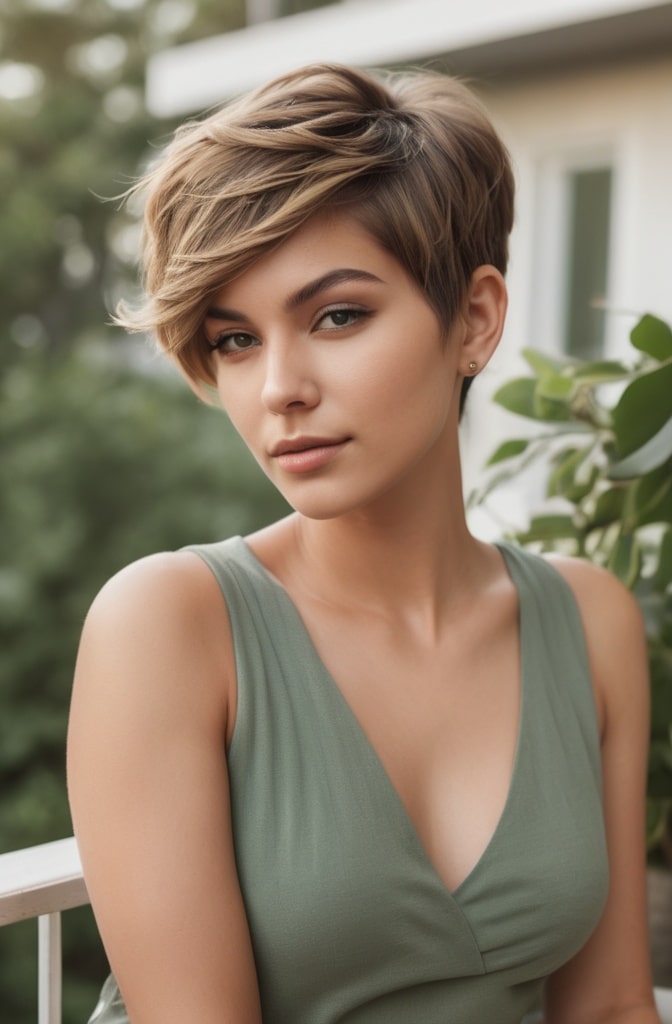
The long feathered pixie (sometimes called a “pixie bob” or “bixie”) features longer layers throughout that typically graze the nape and ears, with feathered elements adding movement and preventing heaviness. This longer variation is perfect for those hesitant to go super short, offering a middle ground between a traditional pixie and a short bob. The extended length retains enough hair to play with different styling options, from sleek and polished to messy and textured.
For women transitioning from longer styles, this cut serves as an excellent gateway into the pixie world without the shock of an extreme change. The additional length around the face can be customized with face-framing layers or side-swept bangs that soften angular features and create a flattering silhouette. It’s also a great choice for those growing out a shorter pixie, as the proportions can be adjusted as your hair lengthens without loosing the stylistic integrity of the cut.
4. Undercut Feathered Pixie
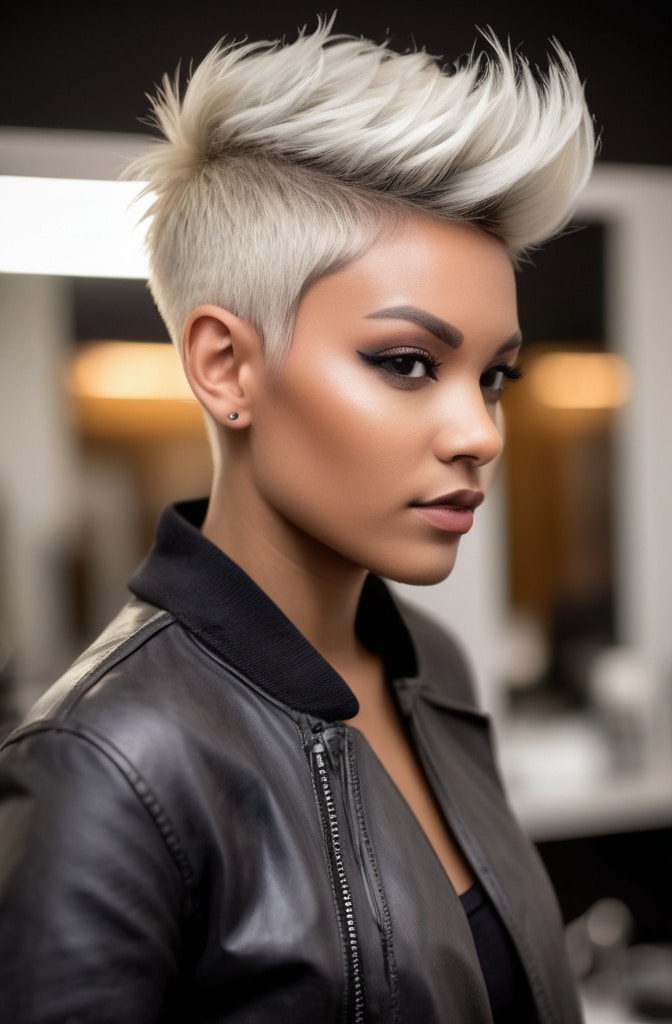
An undercut feathered pixie combines the edginess of shaved sections with the softness of feathered layers on top, creating a stunning contrast that’s both bold and feminine. Usually, the sides and back are buzzed short (sometimes with designs for extra personalization), while the top remains longer with feathered ends that can be styled in various directions. This architectural approach to the pixie creates dramatic negative space that emphasizes the movement and texture of the feathered sections.
This style is seriously perfect for thick-haired gals who need help managing volume and weight in there hair. The undercut removes bulk from the areas where it’s typically least needed, allowing the remaining hair to move more freely and show off those gorgeous feathered ends. I’ve had clients literally tear up with joy seeing how much lighter their hair feels with this cut—plus it dries in like half the time of a traditional pixie!
5. Textured Feathered Pixie
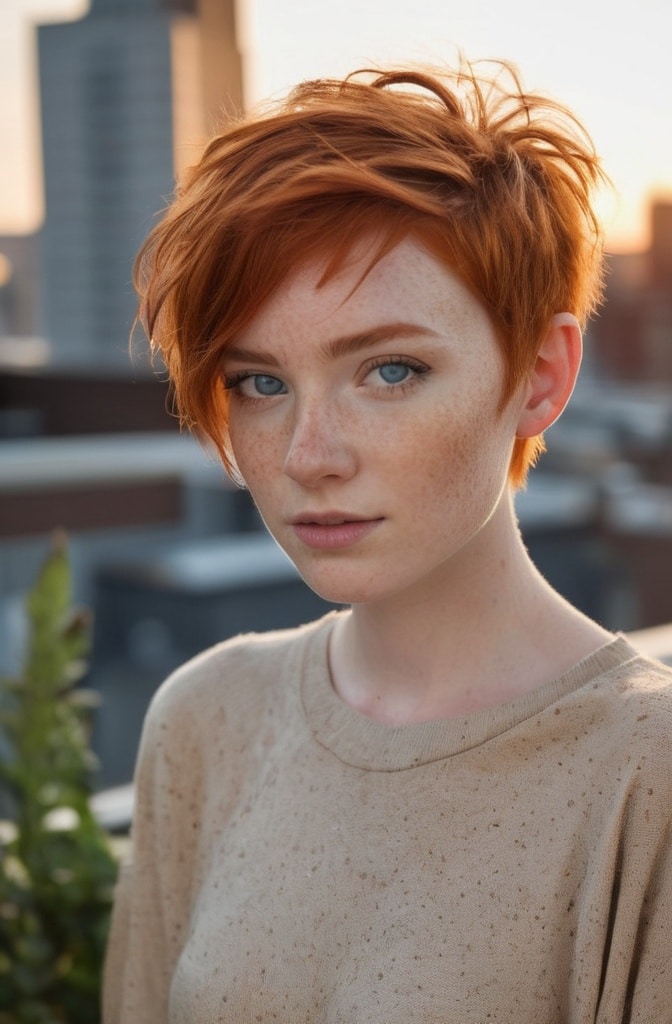
The textured feathered pixie takes layering to the next level, incorporating various cutting techniques like point-cutting, notching, and slicing to create piece-y definition throughout the cut. This approach creates deliberate disconnection between layers, resulting in a tousled, effortlessly cool look with tons of natural movement. The combination of texturizing and feathering creates soft, wispy ends that move beautifully even with minimal styling.
This variation works wonders for those with naturally wavy or slightly curly hair, as it embraces and enhances natural texture rather than fighting against it. The deliberate “imperfection” of the cut means it actually looks better when it’s not perfectly styled, making it ideal for the woman who prefers a lived-in, undone aesthetic over precision. I always tell my clients this style is like the perfect pair of worn-in jeans—comfortable, flattering, and somehow looking even better on day two or three.
6. Feathered Pixie with Long Bangs
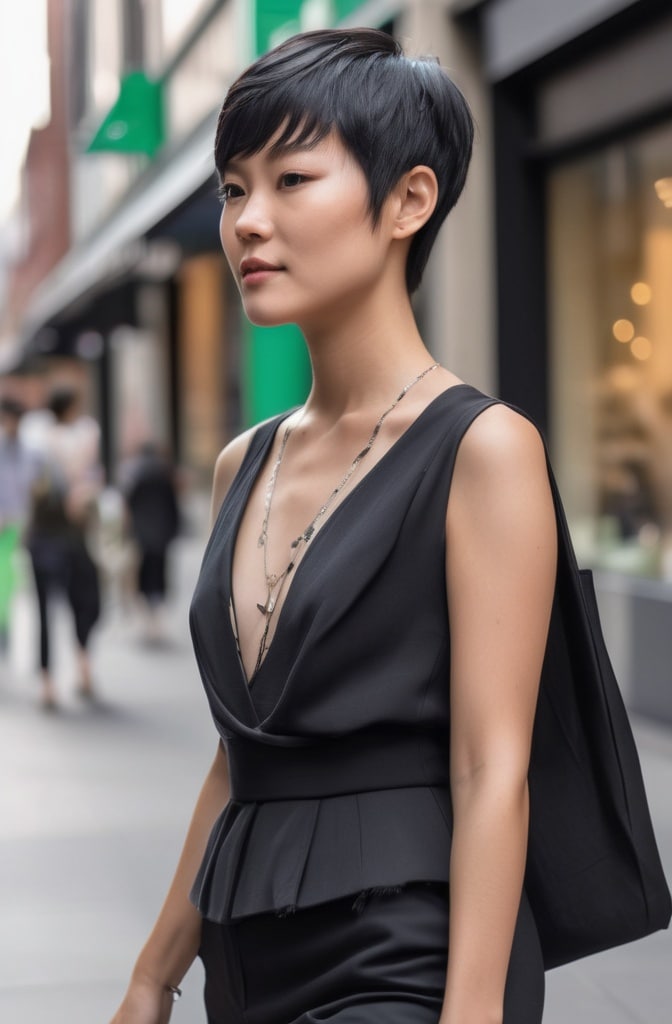
The feathered pixie with long bangs features short, layered sides and back with significantly longer fringe that can be swept across the forehead or styled up and away from the face. This variation puts the focus on the eyes and cheekbones while the length in the bangs offers styling versatility that other pixie variations might lack. The contrast between the short back and sides and the longer front creates a compelling visual rhythm that’s both sophisticated and playful.
Many of my clients choose this style when they want the convenience of short hair but aren’t ready to give up the security of having some hair to play with around their face. The longer bangs can be adjusted to flatter any face shape—swept to the side for round faces, blunt for long faces, or curtained for square faces. Its also great for growing out shorter bangs cuz the transition feels intentional rather than awkward, allowing you to shift your style with minimum fuss during that in-between phase.
7. Feathered Pixie for Curly Hair

The feathered pixie for curly hair embraces natural texture while incorporating specialized cutting techniques that allow curls to spring up and show their natural pattern. Unlike straight-haired pixies, this variation typically leaves slightly more length to account for shrinkage and uses careful feathering to remove weight without creating frizz or disrupting curl formation. The result is a shape that works with—rather than against—natural curl patterns for a cut that enhances what you were born with.
This style completely revolutionizes curl management for many women, turning what might have been a time-consuming routine into something refreshingly simple. The shorter length means fewer tangles, faster drying time, and better product distribution for more defined curls. I’ve watched so many curly-haired clients discover a whole new relationship with there hair after going for this cut—suddenly embracing there natural texture instead of fighting it every morning.
8. Feathered Pixie with Micro Bangs
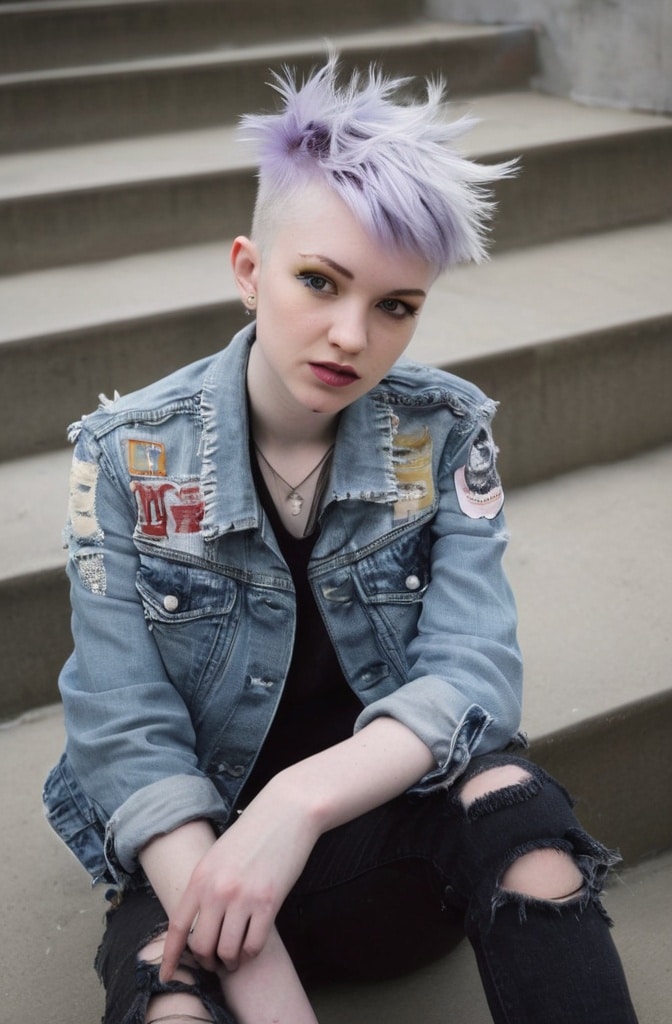
The feathered pixie with micro bangs combines the softness of feathered layers with ultra-short, straight-across fringe that typically ends mid-forehead. This bold combination creates a striking frame for the face, drawing immediate attention to the eyes while the feathered elements throughout the rest of the cut keep the overall look soft and feminine. The contrast between the blunt bangs and the textured layers creates architectural interest that’s both modern and slightly retro.
This style requires a certain confidence to pull off, but the women who choose it tend to become absolutely devoted to the look. The micro bangs make a statement without requiring the commitment of overall length, allowing for a unique look that stands out in a crowd. It pairs particularly well with bold eyewear or statement earrings, creating a cohesive aesthetic that reads as intentional and fashion-forward without trying to hard or looking overly styled.
9. Soft Feathered Pixie for Fine Hair
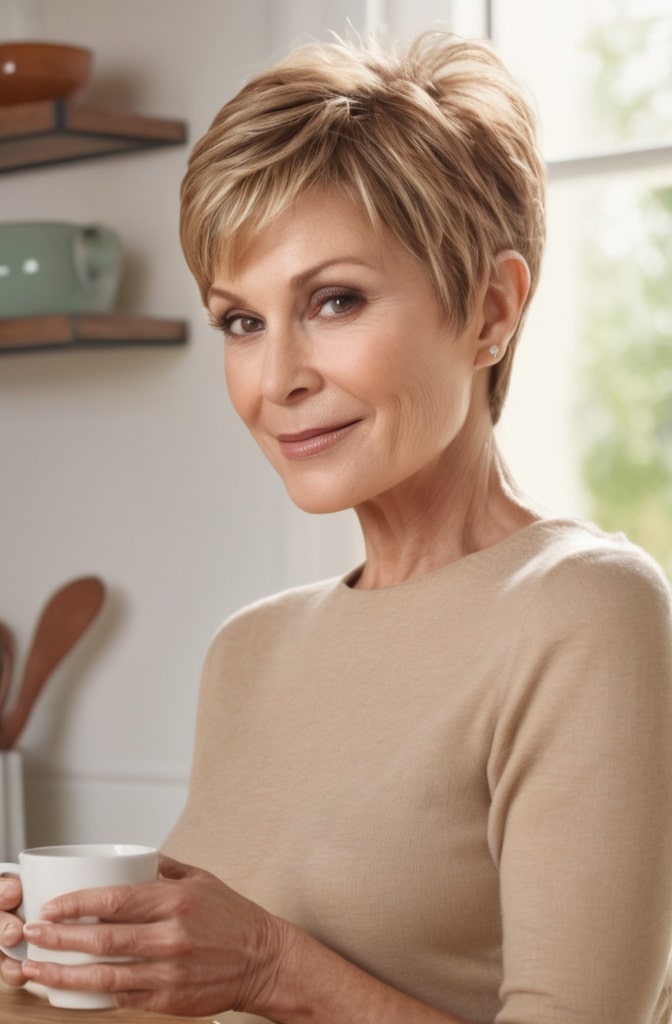
The soft feathered pixie for fine hair incorporates gentle layering techniques that create the illusion of density without exposing the scalp or making hair look thinner. This specialized approach uses feathering to build subtle volume at the crown while keeping the overall silhouette close to the head for a sleek, elegant line. The soft, wispy ends create movement without the harsh “choppiness” that can sometimes make fine hair look even thinner.
For my clients with finer hair textures, this cut can be literally transformative—suddenly their hair appears thicker, more dynamic, and far easier to style than it was at longer lengths. The shorter length allows natural oils to distribute more evenly, giving the hair a healthier sheen, while the right cutting technique creates natural lift at the roots that lasts longer between washes. Its honestly the perfect example of how sometimes less hair actually equals more volume when cut properly.
10. Layered Feathered Pixie
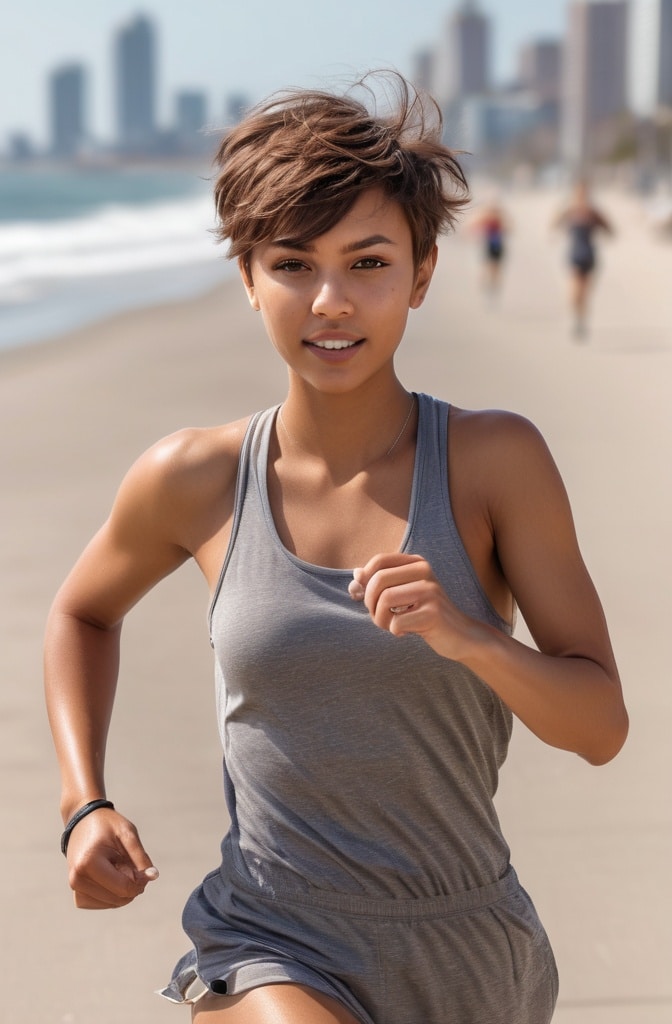
The layered feathered pixie incorporates multiple lengths throughout the cut, creating dimension and movement that can be customized to flatter any face shape or hair texture. Unlike some more uniform pixie cuts, this variation plays with contrasting lengths—perhaps longer on top, medium around the crown, and shorter at the nape—with feathered ends throughout that soften transitions between layers. This approach creates natural volume at the crown while maintaining a sleek silhouette around the ears and nape.
What I love about this particular variation is how adaptable it is to almost any hair type or personal style preference. The varying layers can be adjusted to work with cowlicks, growth patterns, or areas of thinning, making it one of the most customizable pixie options. When styled, the different lengths catch the light in subtly different ways, creating natural dimension that makes hair look thicker and more vibrant without requiring complicated coloring techniques or excessive product.
11. Feathered Pixie with Side Sweep
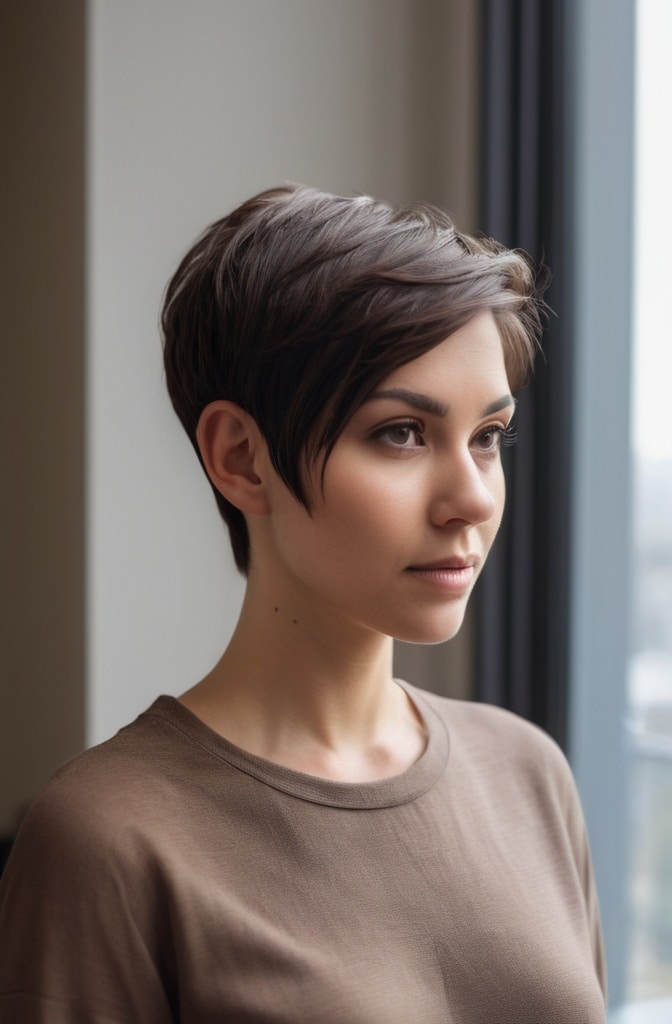
The feathered pixie with side sweep features longer layers on top that are cut specifically to be directed across the forehead in a dramatic side-swept fashion. This glamorous variation adds a touch of old Hollywood to the modern pixie, creating a partial veil across one side of the face that’s both mysterious and flattering. The feathering technique ensures that even with the longer top section, the style maintains movement and doesn’t fall flat.
This style is especially effective for balancing asymmetrical facial features or softening stronger jaw lines, as the diagonal line of the sweep creates visual interest that draws attention away from areas you might prefer to deemphasize. Many of my clients find this variation gives them the versatility of longer hair with the convenience of a pixie—they can wear it sleek for formal occasions, textured for everyday, or even pinned back when they need it completely off there face for activities or hot weather.
12. Shaggy Feathered Pixie
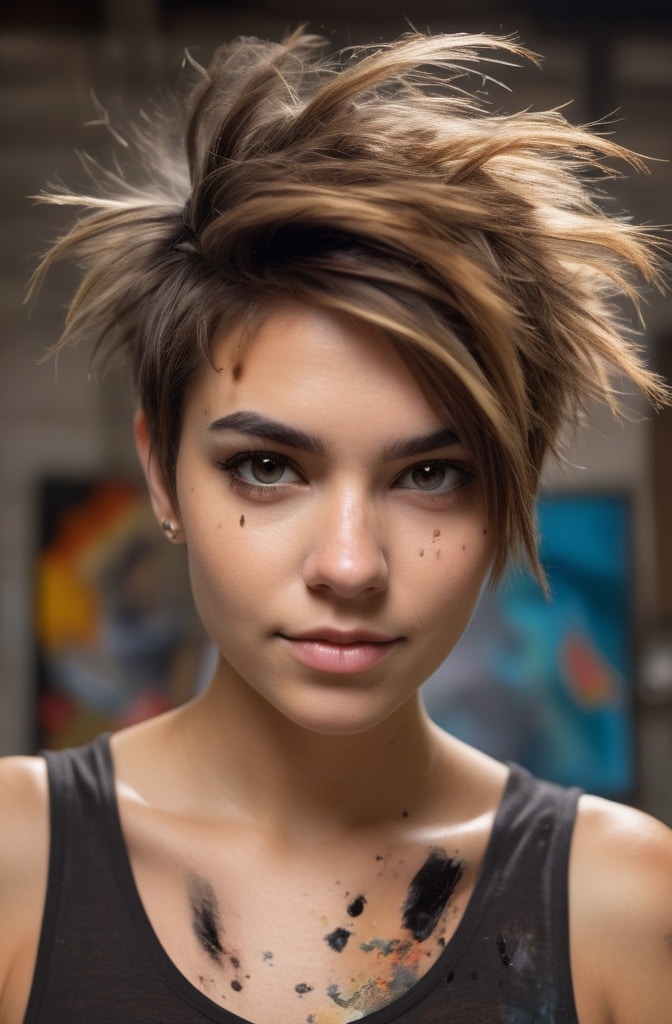
The shaggy feathered pixie incorporates elements of the classic 70s shag into a shorter silhouette, featuring lots of choppy layers, disconnection, and feathered ends that create a deliberately “undone” aesthetic. This rebellious take on the pixie embraces natural texture and movement, with layers that seem to fall effortlessly into place with minimal styling. The shagginess adds volume at the crown and around the face while the feathered technique softens the ends for movement.
I find this style particularly liberating for clients who’ve spent years fighting their natural hair patterns—suddenly, that cowlick becomes a feature rather than a problem, and that weird wave becomes part of the cut’s character. The shaggy pixie looks even better slightly grown out, making it amazing for those who can’t get to the salon every few weeks for maintenance. It’s like the pixie equivalent of perfectly worn-in jeans—comfortable, flattering, and somehow looking better the less you fuss with it.
13. Feathered Pixie with Nape Designs
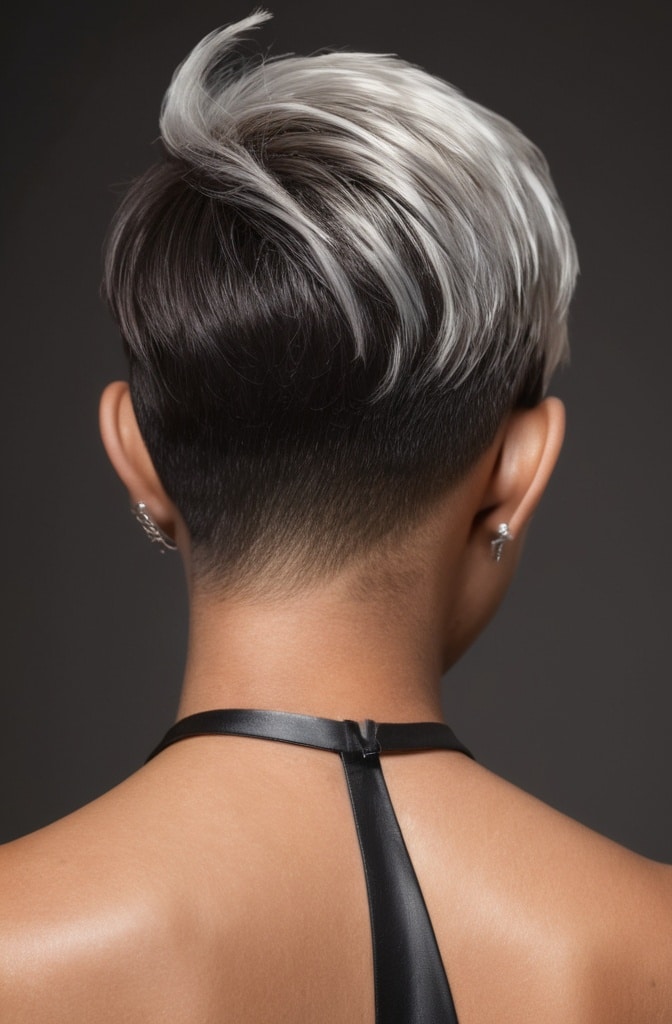
The feathered pixie with nape designs features traditional pixie elements on top with creative shaved patterns or designs at the nape of the neck, visible only when the hair is worn up or from behind. This playful variation allows for personal expression in an area that’s typically hidden, creating a surprising element that can be revealed or concealed depending on how you style the rest of your hair. The contrast between the soft, feathered top and the precise lines of the undercut creates a compelling juxtaposition.
This style offers a unique opportunity to experiment with more edgy elements without committing to a fully visible undercut or shaved sides. I’ve created everything from simple geometric patterns to elaborate designs in this hidden area, giving clients the chance to express their personality in a way that doesn’t impact their professional appearance when needed. It’s also a fantastic option for those who want to experiment with hair art but aren’t ready for a more dramatic change to there overall look.
14. Tapered Feathered Pixie
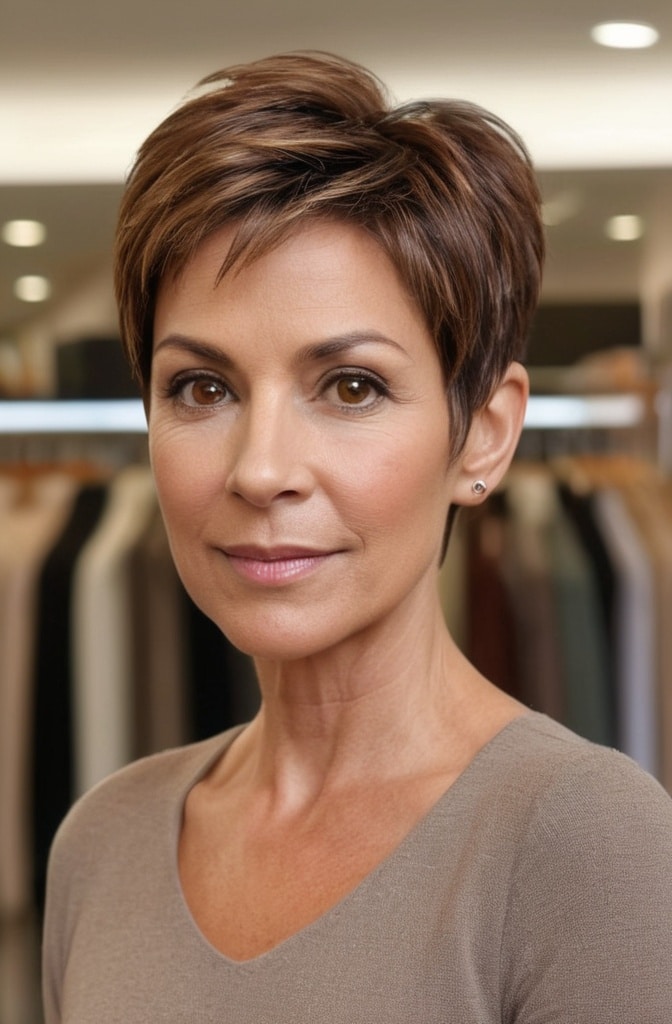
The tapered feathered pixie features a smooth graduation from very short hair at the nape and sides to longer, feathered layers on top, creating a seamless transition between lengths. This technical approach creates a sleek silhouette that follows the natural shape of the head while the feathered elements on top add movement and prevent the cut from looking too severe or military-inspired. The precision of the tapering requires skilled cutting but results in a low-maintenance style that grows out gracefully.
What makes this variation special is the beautiful balance between masculine and feminine elements—the tapered sides provide the clean lines and precision of a traditional men’s cut, while the feathered top maintains a softness that’s undeniably feminine. Many of my clients who choose this style appreciate how it enhances there facial structure without requiring them to sacrifice there femininity. The graduated nature of the cut also means it typically needs less frequent trims than some other pixie variations, as the growing-out phase maintains the intentional shape longer.
15. Feathered Pixie with Disconnected Layers
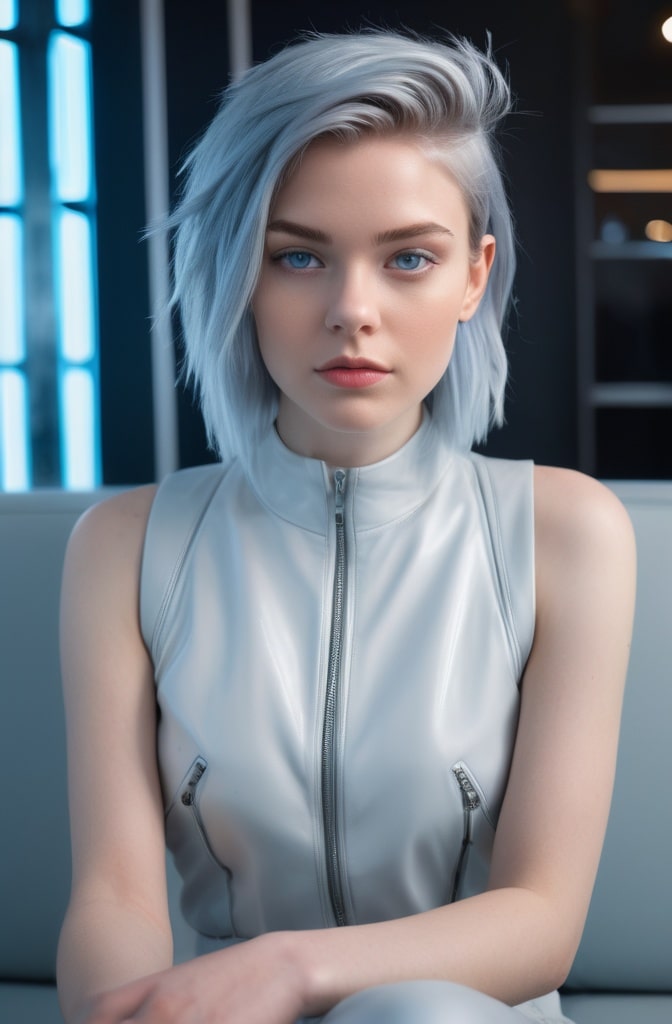
The feathered pixie with disconnected layers creates deliberate separation between different sections of the cut, typically with a distinct difference between the top and sides rather than a smooth transition. This architectural approach creates dramatic contrast and visual interest, with the disconnection allowing for creative styling options that wouldn’t be possible with a more blended cut. The feathering technique softens what could otherwise be harsh lines between the disconnected sections.
This style has an inherently editorial quality that photographs beautifully and makes a statement even when minimally styled. I’ve found it particularly impactful on clients with naturally straight, thick hair, as the disconnection allows for removal of bulk in specific areas while maintaining length where desired. The dramatic nature of this cut means it has presence—it’s not a style that disappears into the background, but rather one that announces itself with confidence and intention.
16. Feathered Pixie for Thick Hair
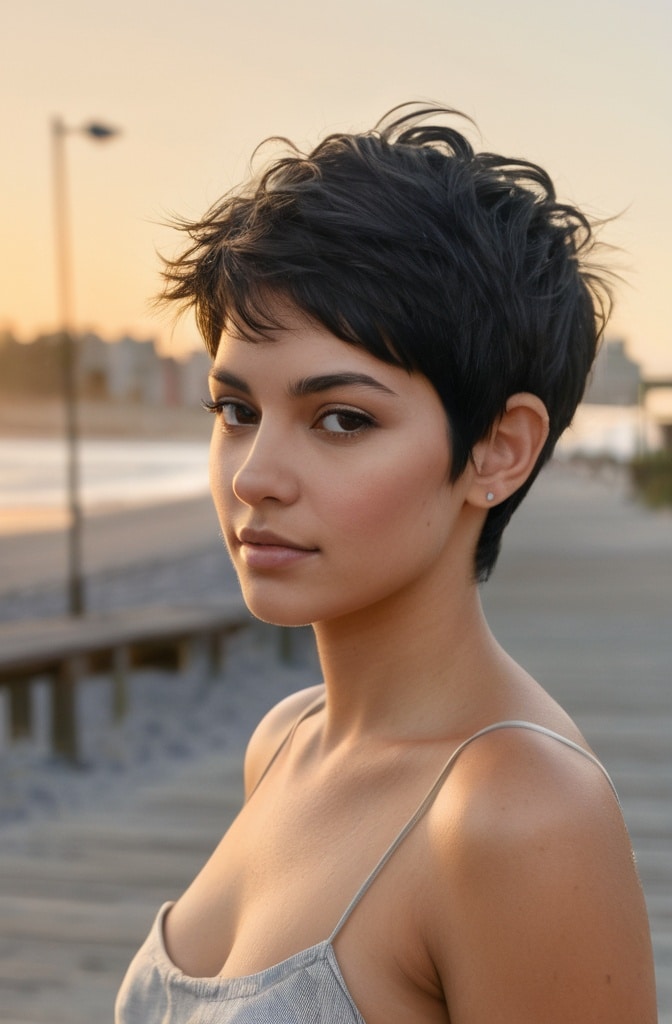
The feathered pixie for thick hair incorporates strategic layering and texturizing to remove bulk without creating poofiness or an overly round silhouette. This specialized approach uses feathering not just for style but as a technical solution to manage heavy hair, creating movement and preventing the heaviness that can make thick hair in a pixie look helmet-like. The layers are typically more pronounced than in other pixie variations, with significant weight removal throughout.
For my thick-haired clients, this cut can be absolutely life-changing—suddenly managing their hair becomes simple rather than a daily battle. The right cutting technique transforms what could be an overwhelming mass of hair into something light, manageable, and flattering that actually takes advantage of their natural thickness rather than fighting against it. Many find they need far less product and heat styling with this cut, as the hair naturally falls into place in a way that wasn’t possible with longer styles.
17. Feathered Pixie-Bob Hybrid
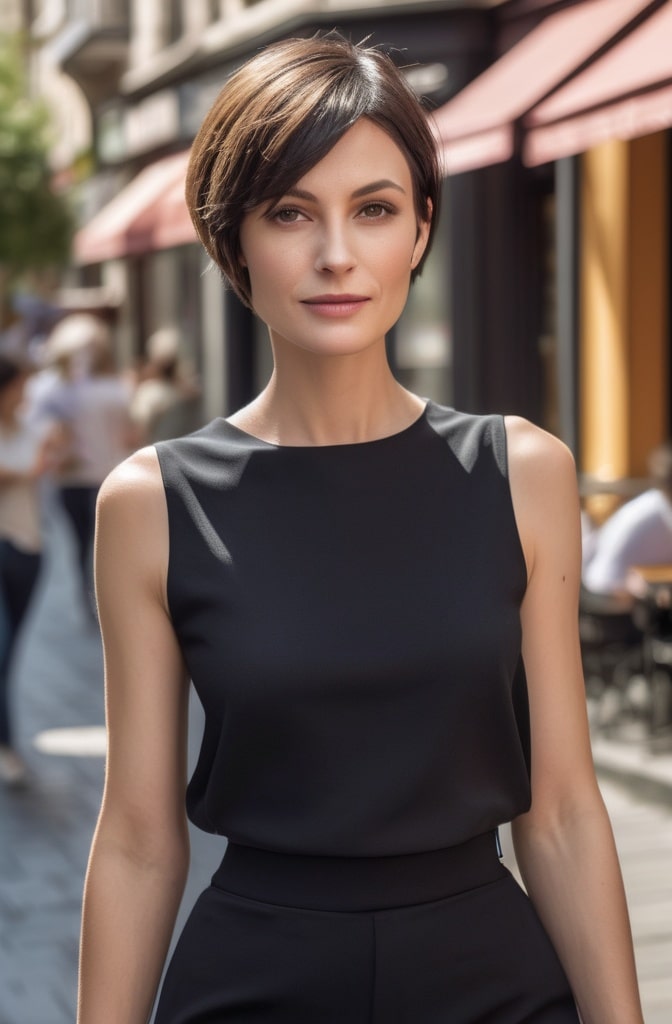
The feathered pixie-bob hybrid (sometimes called a “bixie”) bridges the gap between a traditional pixie and a short bob, featuring pixie-like layering at the crown with longer, bob-like elements around the perimeter. This versatile cut offers the best of both worlds—the face-framing benefits and nape coverage of a bob with the volume and texture of a layered pixie. The feathering technique softens the transitions between the different lengths, creating a cohesive look despite the hybrid nature.
This style has become increasingly popular among my clients who want to transition from longer hair to a pixie without making the leap all at once. The familiarity of having some length around the ears and nape provides security while still allowing them to experiment with the freedom of shorter hair on top. It also works brilliantly as a transitional style for growing out a shorter pixie, as the longer perimeter can be maintained while the top sections catch up, avoiding that awkward growing-out phase.
18. Feathered Pixie with Color Dimension

The feathered pixie with color dimension combines strategic highlighting, balayage, or multiple tones throughout the cut to enhance the feathered layers and create visual depth. This color-focused approach uses light and dark placement to accentuate the movement created by the feathering technique, making the texture pop and the layers more visible. The result is a multidimensional look that appears to have more volume and movement than a single-toned pixie.
I’ve watched this technique transform even the most basic pixie cut into something extraordinary, as the interplay of light and shadow created by the color variation brings the layers to life in a way that cutting alone cant achieve. For clients with naturally mousy or flat-colored hair, adding even subtle dimension can make there pixie look infinitely more expensive and intentional. The feathered elements provide the perfect canvas for these color techniques, as each wispy end catches the light differently.
19. Feathered Pixie for Mature Women

The feathered pixie for mature women incorporates age-appropriate elements that flatter changing face shapes and hair textures while maintaining a youthful, contemporary feel. This specialized variation typically features softer lines around the face, strategically placed length to camouflage areas of concern (like the neck or jawline), and feathering techniques that add movement without creating sparse areas where hair might be thinning. The overall effect is elegant and refined without looking dated or matronly.
For my clients in their 50s, 60s, and beyond, this cut often becomes a signature style that they maintain for years, making small adjustments as their features and preferences evolve. The shorter length showcases elegant earrings and necklines, draws attention to the eyes, and projects confidence—all while being incredibly practical for active lifestyles. Many women find that embracing a well-executed pixie at this stage of life feels liberating, removing the pressure to maintain long hair that might no longer suit there changing texture or density.
20. Feathered Pixie with Temple Undercut
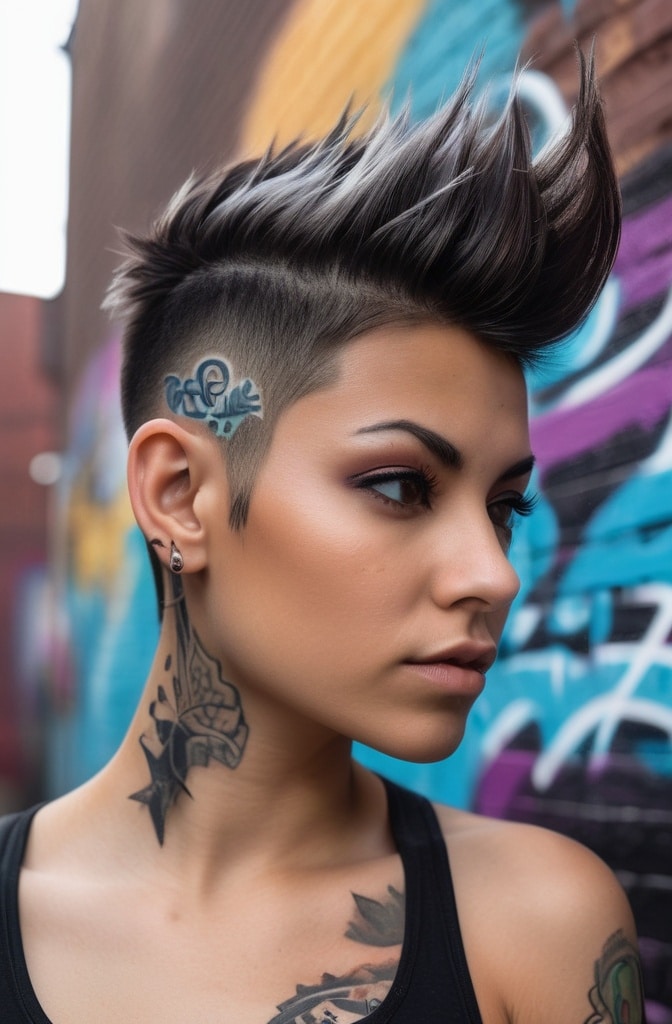
The feathered pixie with temple undercut features shaved or very short sections at the temples while maintaining feathered length through the top and potentially the sides and back. This strategic placement draws attention upward and creates negative space that frames the eyes and cheekbones, often with a slightly asymmetrical effect that adds edge to the otherwise soft feathered elements. The contrast between the shaved sections and the feathered layers creates a compelling juxtaposition.
This style offers a unique compromise for those who want to experiment with undercut elements without committing to shaving larger sections of their head. The temple placement is also easily concealed if needed—when the longer top sections are worn down, the undercut is barely visible, but when pushed back or worn up, the design element is revealed. I’ve had many clients start with this variation as a “gateway” to more dramatic undercut styles, allowing them to test the waters before making a bigger commitment.
21. Feathered Pixie with Razored Edges

The feathered pixie with razored edges uses razor-cutting techniques to create ultra-fine, wispy ends throughout the cut, resulting in a soft, diffused perimeter rather than the more definitive line of scissor-cut ends. This specialized approach creates movement and texture even in the finest hair, with the razor’s natural thinning effect creating feathered pieces that separate beautifully when styled. The overall effect is ethereal and lightweight, with ends that seem to disappear rather than stop.
The technical precision required for successful razor-cutting means this isn’t a style every stylist can execute well, but when done properly, the results have an editorial quality that scissor-cutting simply cannot achieve. For clients with very fine or straight hair, razor-cutting can actually create the illusion of more texture and density, as the varied lengths and wispy ends catch the light differently and create dimension. It’s probably my favorite technique for creating truly unique pixies that don’t look like everyone else’s cut.
22. Feathered Pixie for Square Faces
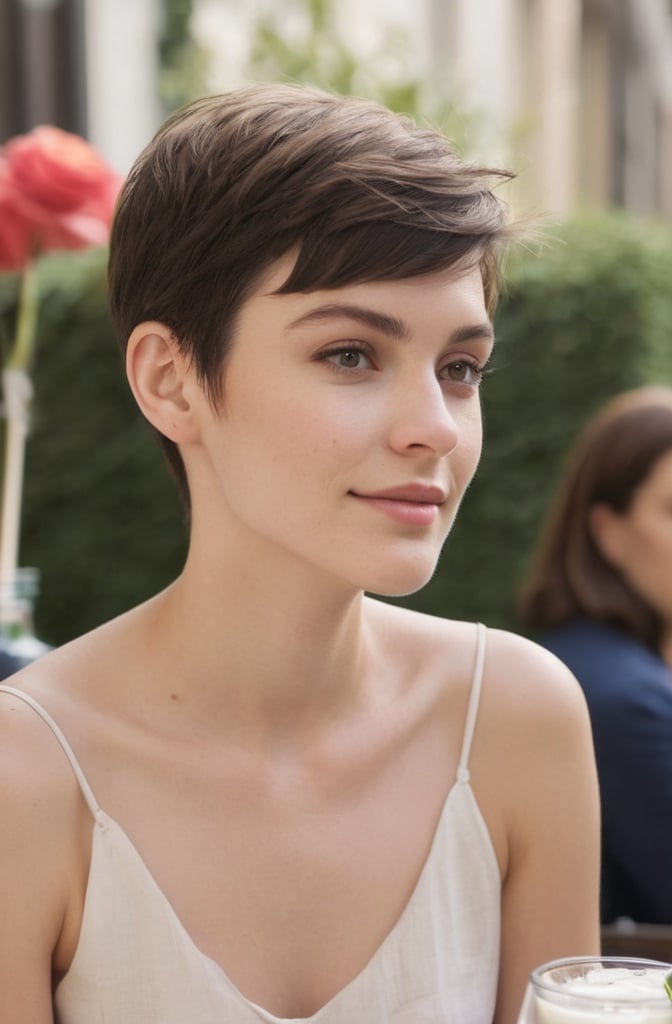
The feathered pixie for square faces incorporates strategic layering and feathering techniques that soften angular jawlines and create balance with the forehead. This face-specific variation typically features longer, side-swept elements that break up the squareness of the face, with feathered pieces around the temples and cheekbones that create softness where needed. The layers are arranged to add height at the crown, lengthening the face vertically to counterbalance its width.
I’ve seen this customized approach completely transform the way a square-faced client perceives their features—suddenly, what might have been seen as a too-strong jaw becomes a sophisticated statement framed by softening layers that complement rather than fight against the natural facial architecture. The feathering technique is crucial here, as it prevents hard lines in the haircut that would echo the angles of the face. Many clients are amazed at how a properly customized pixie actually flatters there face shape better than the longer styles they’d been hiding behind.
23. Wind-Swept Feathered Pixie
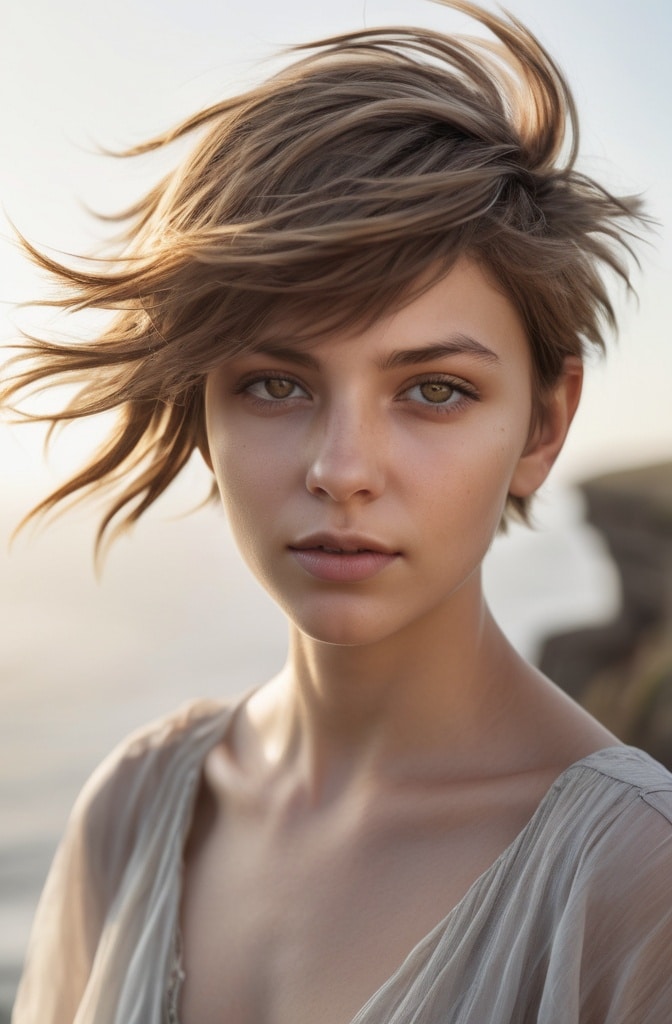
The wind-swept feathered pixie creates the illusion of hair naturally blown by the breeze, with layers deliberately cut to sweep in a specific direction (typically up and away from the face). This dynamic variation incorporates feathering techniques that allow the hair to separate into wispy pieces that appear to be caught in motion, creating a sense of movement even when the hair is completely still. The effect is effortlessly cool, with a slightly tousled finish that never looks too perfect or contrived.
This style is cut in a way that makes it nearly impossible to style incorrectly—the hair almost wants to fall into this swept pattern, making daily styling remarkably simple. For many of my clients with active lifestyles, this becomes there go-to cut because it actually looks better slightly messy, with the lived-in quality enhancing rather than detracting from the intended aesthetic. It’s one of those rare styles that genuinely does look like you just rolled out of bed looking effortlessly chic.
24. Feathered Pixie with Curtain Bangs

The feathered pixie with curtain bangs incorporates the trendy split-center fringe into a shorter overall cut, creating a face-framing effect that’s both current and flattering for most face shapes. This contemporary variation features the shorter back and sides of a traditional pixie with longer, center-parted bangs that sweep outward on either side of the face like curtains. The feathering technique softens the bangs’ edges, creating movement that blends seamlessly with the rest of the cut.
This style has become increasingly requested in my chair, as it offers the perfect middle ground for clients who want the ease of a pixie but aren’t ready to give up the security of having some hair around there face. The curtain element is remarkably versatile—it can be worn more dramatically parted for a bolder look, or more blended for a subtle effect, making it adaptable to different occasions and styling preferences. It also grows out beautifully, transitioning into a longer pixie or bob without awkward in-between stages.
25. Dramatic Feathered Faux-Hawk Pixie
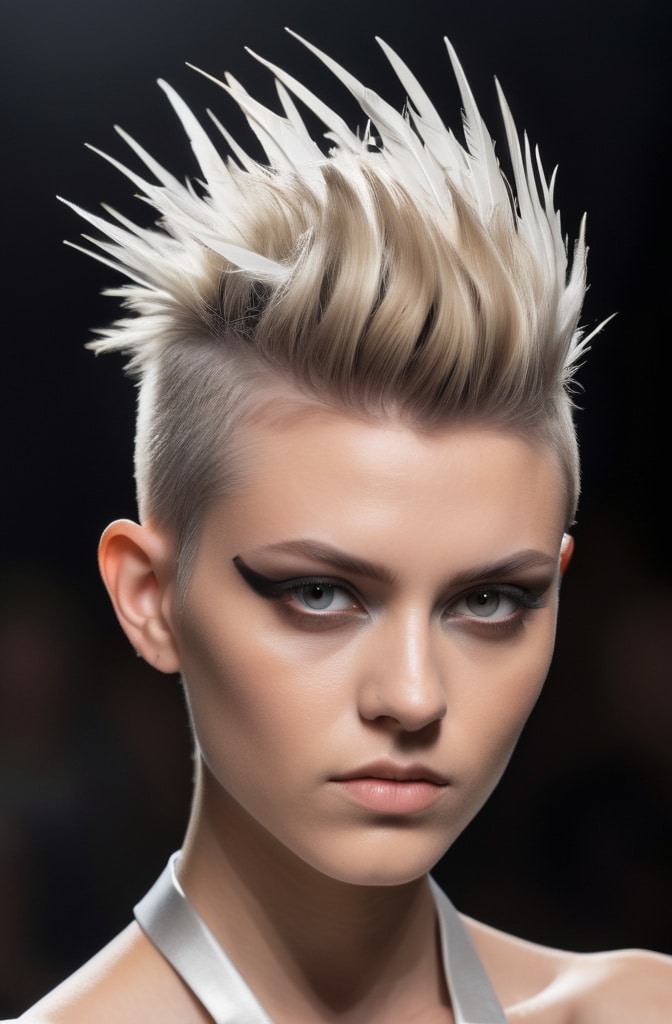
The dramatic feathered faux-hawk pixie features significantly longer length down the center of the head from forehead to nape, with shorter, feathered sides that create the silhouette of a mohawk without the commitment of actually shaving the sides. This bold variation plays with proportion and height, often styled to stand up along the center strip for maximum impact while the feathered sides create texture and movement that softens what could otherwise be a harsh look.
Despite its edgy appearance, this style is surprisingly versatile—when styled up, it makes a dramatic statement for evenings or special events, but when worn flatter or swept to the side, it can easily transition to more conservative environments. I’ve created this style for clients ranging from creative professionals to stay-at-home moms who want something with personality that doesn’t box them into a single aesthetic. The feathering is essential to the success of this variation, as it prevents the longer center section from looking too severe or disconnected from the rest of the cut.
26. Feathered Pixie with Beveled Nape
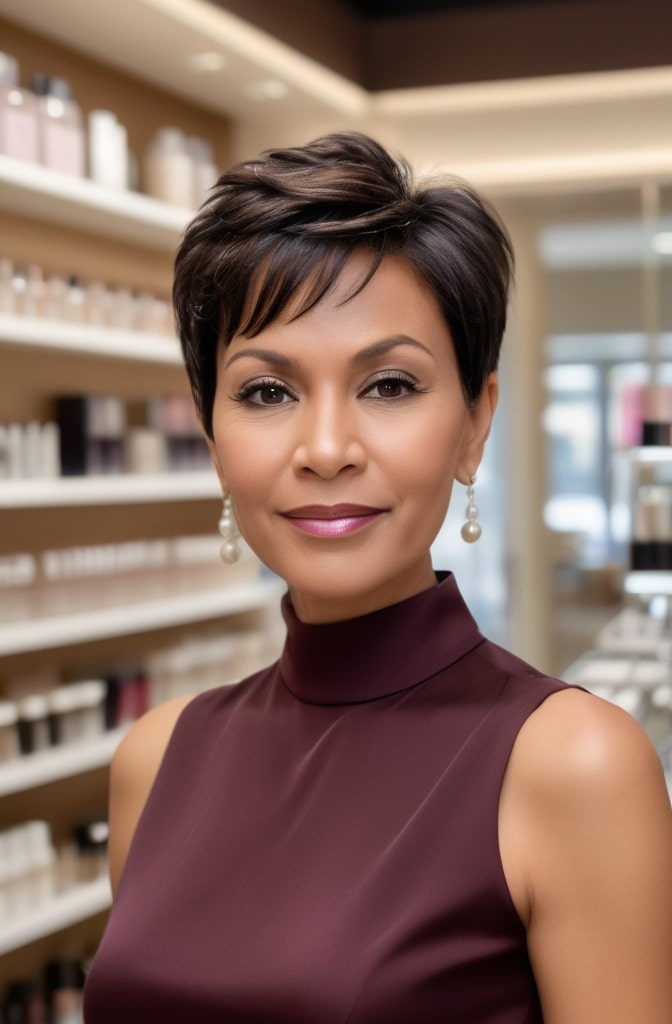
The feathered pixie with beveled nape features a distinctive curved cutting technique at the neckline that creates a subtle concave shape rather than a straight or convex line. This architectural detail adds unexpected dimension to the back view of the pixie, creating a feminine curve that follows the natural shape of the skull while the feathered elements throughout the rest of the cut maintain movement and softness. The beveled nape is particularly flattering for women with longer necks or those who wear their hair tucked behind the ears.
What makes this style truely special is the way it looks from all angles—most pixie cuts focus on the front and side views, but this variation creates a captivating back profile that’s just as intentional as the front. For clients who spend time in situations where people see them from behind (like teachers, speakers, or performers), this detail adds a level of polish that standard pixies might miss. The precision of the beveled cut also creates a cleaner growout pattern at the nape, extending the time between maintenance cuts.
27. Feathered Pixie with Face-Framing Tendrils
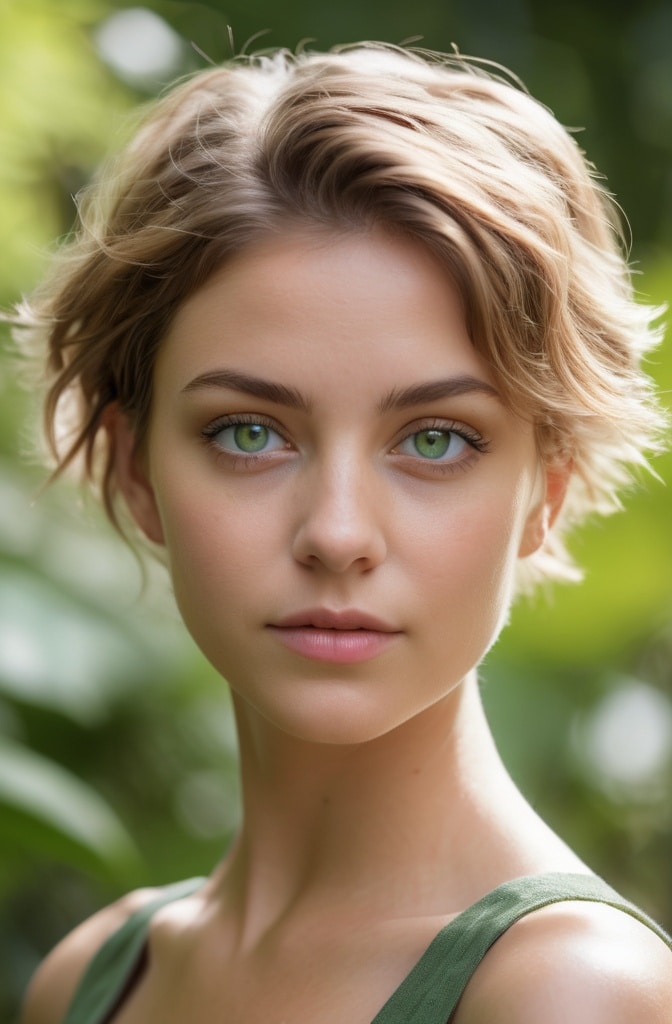
The feathered pixie with face-framing tendrils maintains the short, layered structure of a classic pixie while deliberately leaving a few longer, wispy pieces around the face that can be styled to soften the overall look. These strategic longer sections—typically in front of the ears and sometimes at the temples—create a feminine frame that prevents the pixie from looking too severe while adding movement and dimension. The feathering technique ensures these pieces blend seamlessly with the rest of the cut rather than looking like disconnected elements.
I’ve found this variation works wonders for clients who love the idea of a pixie but worry about losing all softness around there face. The tendrils provide a security blanket of sorts, offering the option to pull a piece forward when desired or tuck everything back for a cleaner look. They’re also incredibly flattering for highlighting cheekbones and drawing attention to the eyes, creating natural contours that enhance facial features without requiring makeup.
28. Highlighted Feathered Pixie
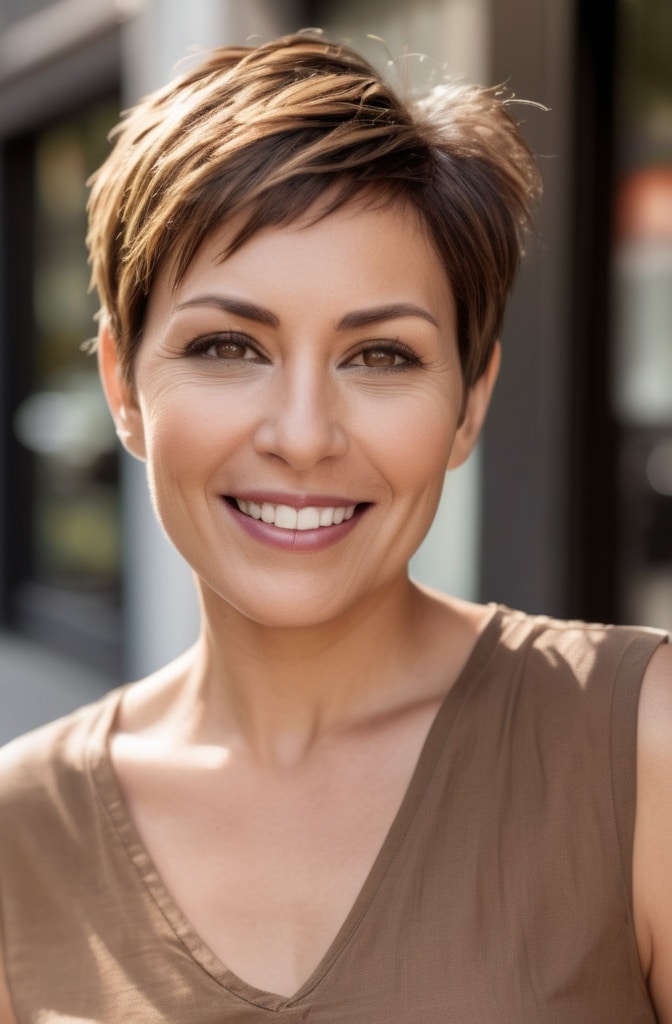
The highlighted feathered pixie incorporates strategic placement of lighter strands throughout the cut, typically concentrated in the longer top sections where the feathering is most prominent. Unlike all-over highlighting, this technique follows the architecture of the cut, with the colorist working closely with the cutting pattern to ensure the highlights accentuate the movement created by the feathering. The result is dimensional color that looks natural and enhances the texture of the cut.
This approach to color transforms the pixie into something truly custom, with the interplay between cutting and coloring techniques creating a result thats far greater than the sum of its parts. For my clients with naturally mousy or one-dimensional hair color, even subtle highlighting can make there pixie look exponentially more expensive and intentional. The best part is that because the highlights are concentrated in the longer sections, they grow out more gracefully than traditional highlighting patterns, requiring less frequent touch-ups.
29. Feathered Pixie with Choppy Crown
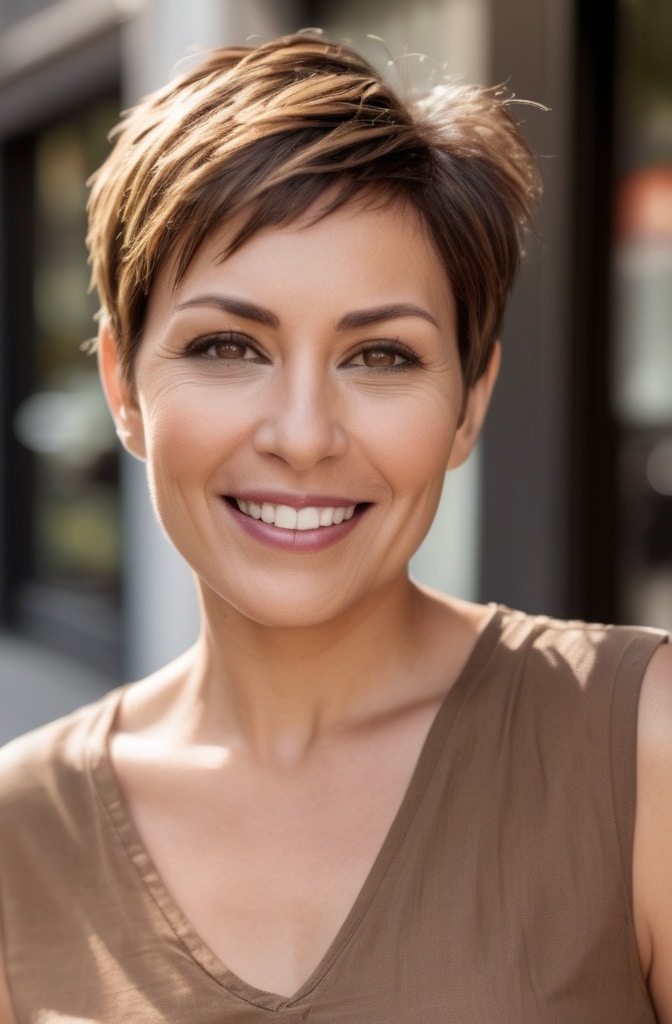
The feathered pixie with choppy crown introduces deliberate, piece-y texture at the top of the head, creating volume and movement where it matters most while maintaining the short, sleek silhouette of a traditional pixie around the perimeter. This specialized cutting technique uses point-cutting and notching to create varied lengths within the crown area, with feathering to soften the ends and ensure the choppy elements don’t look harsh or disconnected from the rest of the cut.
This variation is a game-changer for clients with fine or limp hair, as the choppy technique creates natural volume and lift without requiring excessive product or heat styling. The varied lengths at the crown catch the light differently, creating the illusion of thickness and dimension even in the finest hair textures. I always tell my clients this style is like built-in volumizing product—it gives the hair a natural boost that dosent wash out or fall flat halfway through the day.
30. Feathered Pixie with Wispy Sideburns

The feathered pixie with wispy sideburns features deliberately longer, feathered sections in front of the ears that create a soft frame for the face while maintaining the classic pixie silhouette throughout the rest of the cut. These strategic longer pieces—sometimes called “sideburns” or “ear flares”—soften the transition between hair and face, creating a flattering frame that enhances cheekbones and jaw definition. The feathering technique ensures these sections have movement and lightness rather than appearing heavy or severe.
For clients with wider face shapes or those concerned about a short cut emphasizing fullness in the cheek area, these wispy sections create optical illusions that slim and elongate the face. The soft texture draws the eye vertically rather than horizontally, creating the appearance of a more oval face shape. Many of my clients are surprised by how such a small detail can dramatically change the overall effect of there pixie, transforming what might have been a too-severe look into something soft and incredibly flattering.
31. Feathered Pixie with Rounded Silhouette
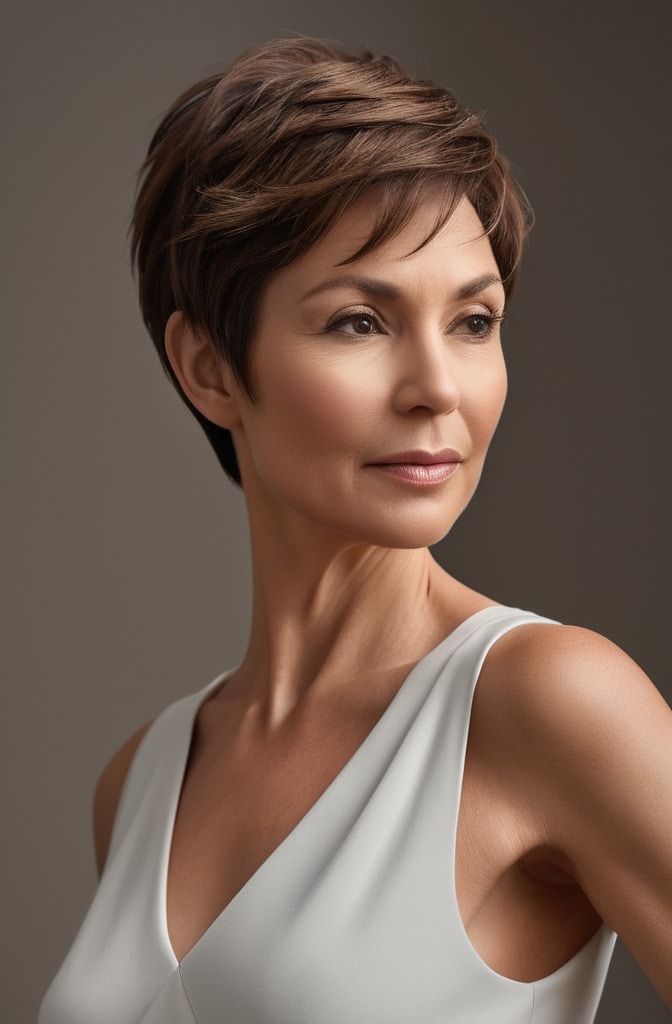
The feathered pixie with rounded silhouette follows the natural curve of the head, creating a smooth, helmet-like shape with no sharp angles or disconnections throughout the cut. Unlike pixies with more architectural elements, this variation prioritizes a soft, continuous line from every angle, with the feathering technique used to prevent any heaviness that might make the rounded shape appear bulky or dated. The result is a feminine, retro-inspired look that’s been updated for contemporary tastes.
This style harkens back to iconic pixies of the 1960s (think Mia Farrow or Twiggy) but with modern cutting techniques that make it fresh and wearable for today’s woman. The rounded silhouette is particularly flattering for those with smaller facial features or petite frames, as it creates harmony and balance rather than overwhelming delicate features. Many of my clients are surprised by how youthful and feminine this shape can be—its proof that short hair can be just as soft and pretty as long hair when cut with intention.
32. Feathered Pixie with Peek-a-Boo Color
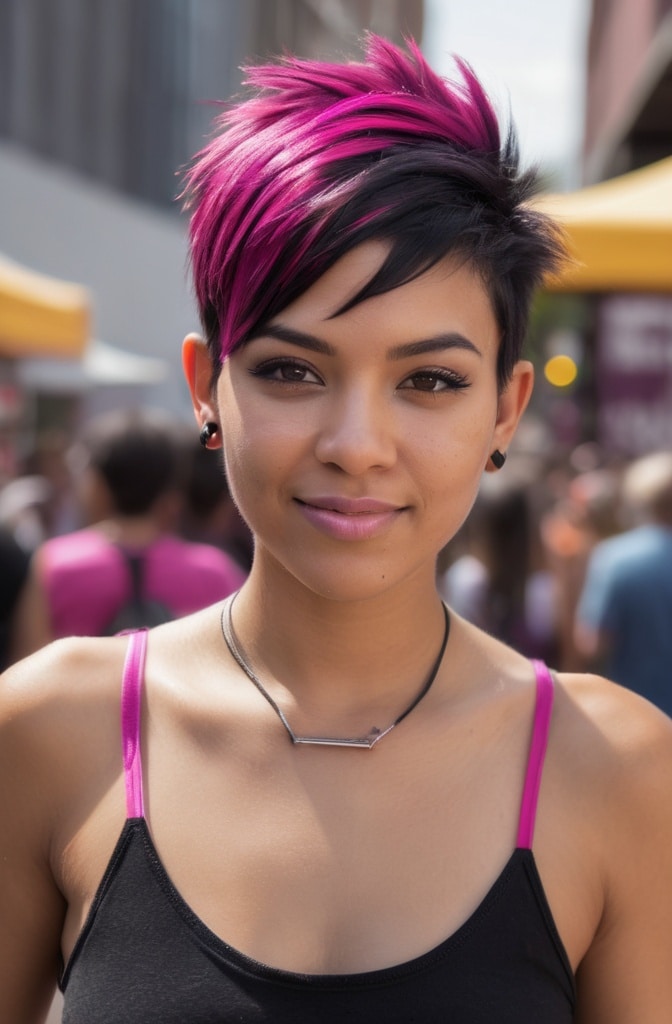
The feathered pixie with peek-a-boo color incorporates vibrant, non-natural color placement in specific sections of the cut—typically underneath longer layers or concentrated in one area—creating surprising pops of color that are visible only from certain angles or when the hair moves. This playful approach to color adds dimension and personality to the pixie without requiring a commitment to all-over vivid color. The feathered cutting technique enhances the reveal/conceal nature of the color placement.
What makes this style so popular amoung my clients is the way it allows for creative expression without compromising professional appearance when needed. The strategic placement means the color can be more visible for social situations (often styled with more texture to reveal the color) or more concealed for conservative environments (styled smoother to hide the vibrant sections). It’s the perfect “business in the front, party in the back” approach to hair color for those who want to experiment without going all-in.
33. Feathered Pixie with Point-Cut Ends
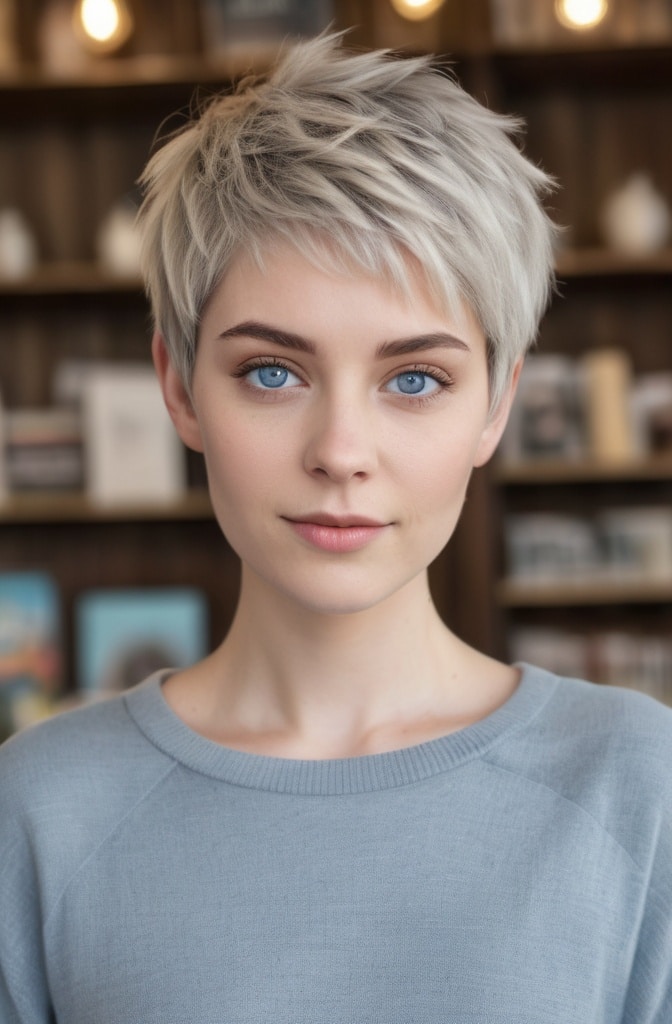
The feathered pixie with point-cut ends uses a specialized cutting technique where the scissors are held vertically and “pointed” into the ends of the hair rather than cutting straight across, creating soft, diffused ends throughout the cut. This technical approach creates natural-looking texture and movement as the varied length of the ends allows the hair to separate into wispy pieces. The result is a lived-in, effortless appearance from day one, with ends that never look freshly cut or too perfect.
This technique elevates the standard pixie to something with editorial quality—the kind of effortless texture that appears in magazines but seems impossible to achieve at home. For my clients with thicker hair, point-cutting removes bulk without creating obvious layers, while for fine-haired clients, it creates the illusion of density and texture without removing too much hair. The best part is how it grows out—the irregular ends mean there’s never a harsh line developing as the hair lengthens, extending the life of the cut by weeks.
34. Feathered Pixie with Curved Fringe
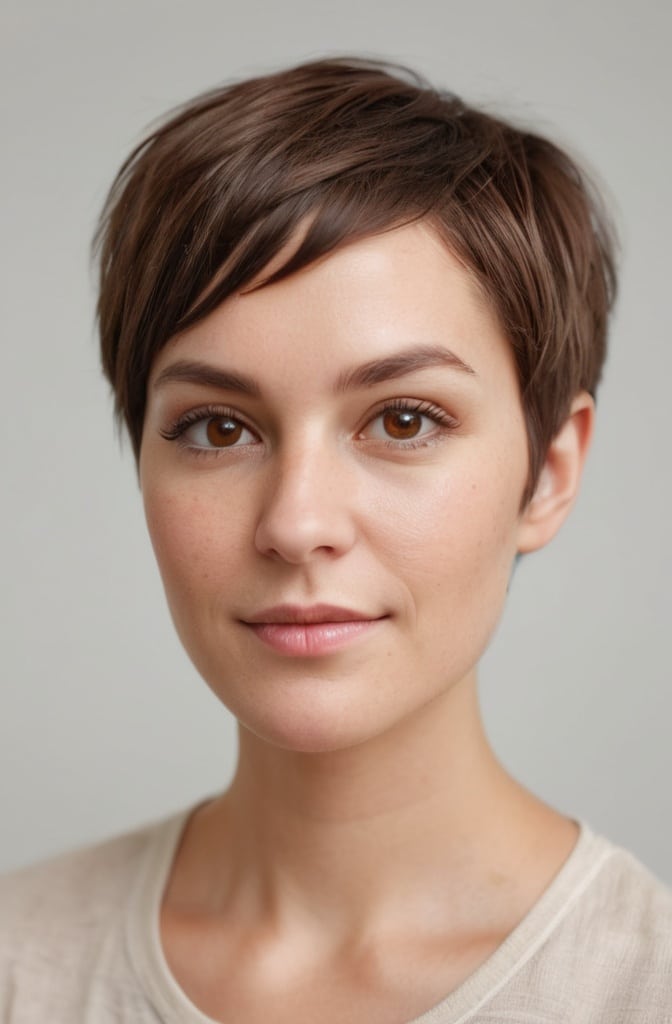
The feathered pixie with curved fringe features a softly rounded bang that follows the natural curve of the forehead rather than cutting straight across or at an angle. This feminine approach to the pixie softens the overall look while drawing attention to the eyes, with the gentle arc of the fringe creating a flattering frame that works particularly well for heart-shaped or long faces. The feathering technique is applied to the ends of the fringe to ensure it blends seamlessly with the rest of the cut.
This style has a timeless quality that transcends trends—the soft curve references classic French-girl fringe while the shortness of the cut keeps it firmly in contemporary territory. My clients who choose this variation often comment on how it opens up there face in a way that’s both youthful and sophisticated. The curved fringe is also remarkably versatile—it can be worn full and blunt for a more dramatic look or piece-y and separated for a softer, more casual vibe depending on styling products and techniques.
35. Feathered Pixie for Diamond Faces
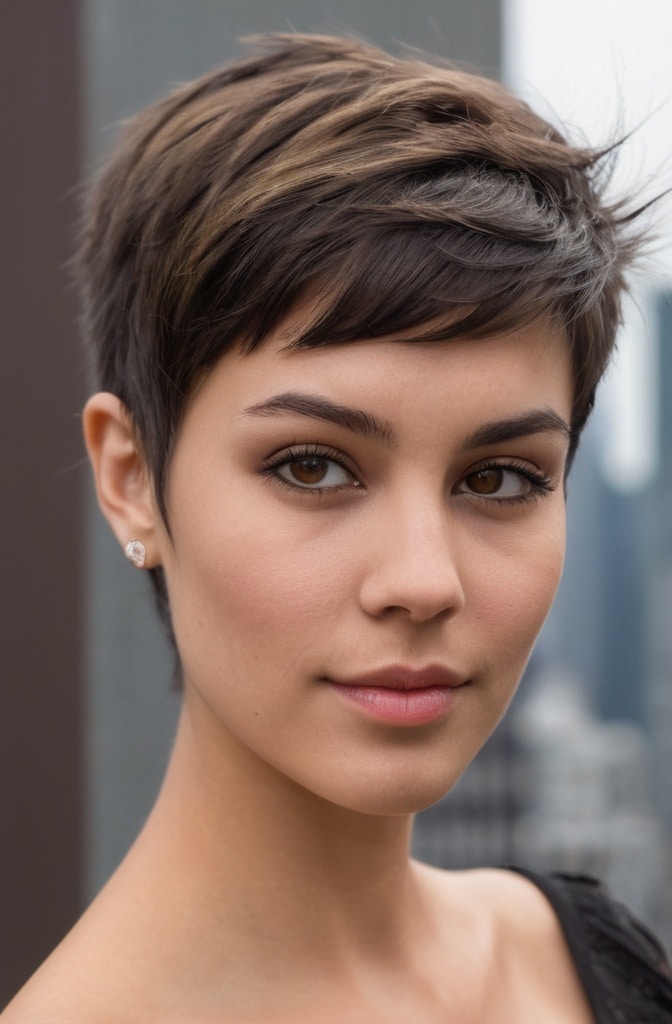
The feathered pixie for diamond faces is strategically designed to balance wider cheekbones with a narrower forehead and jaw, incorporating side-swept elements and softness around the temples where diamond faces need it most. This face-specific variation typically features slightly longer layers through the top that can be styled forward to minimize forehead width, with feathered sections at the cheekbones that diffuse rather than accentuate the widest part of the face. The overall effect creates balance and harmony with natural facial contours.
What makes this specialized approach so effective is the way it works with—rather than against—the natural angles of a diamond-shaped face. Many of my diamond-faced clients have spent years struggling with hairstyles that emphasize their wider cheekbones, making there face shape appear more dramatic than they’d like. The feathered pixie, when properly customized, creates optical illusions that bring the face into better balance, softening angles where needed while highlighting the natural elegance that diamond faces possess.
36. Feathered Pixie with Sculpted Sides
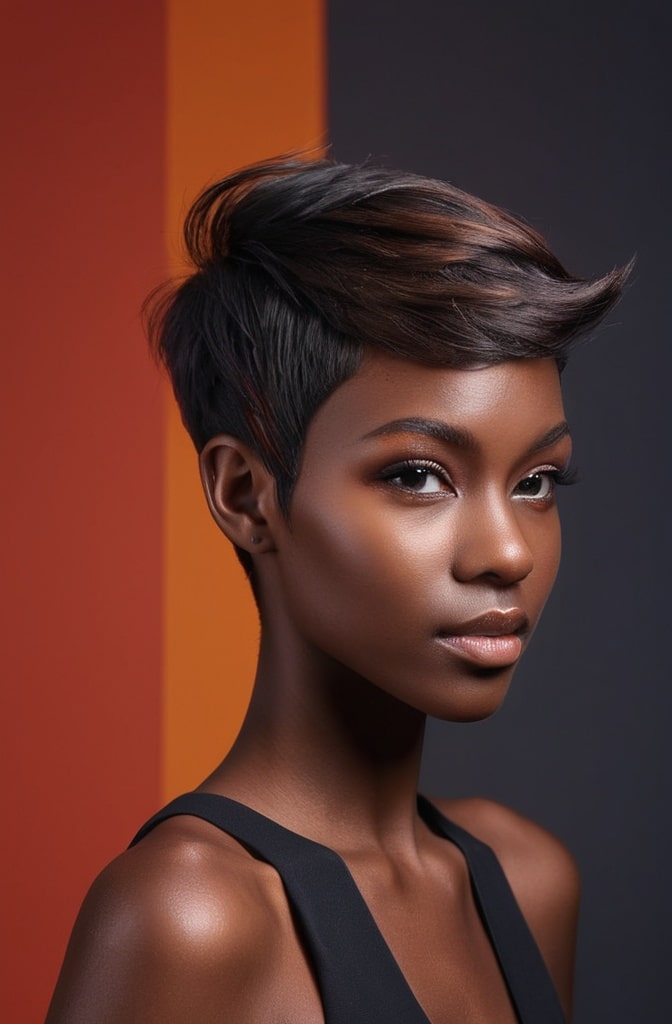
The feathered pixie with sculpted sides features deliberate shaping and contouring along the sides of the head, creating architectural precision that contrasts beautifully with the softer, feathered elements on top. This technical approach uses careful scissor-over-comb techniques to create defined areas that follow the natural contours of the head, with subtle graduation rather than harsh undercut lines. The result is a sophisticated silhouette that looks intentional from every angle.
This style requires significant technical skill to execute properly, as it involves creating shape through precision cutting rather than relying on styling products to achieve the desired look. For clients with good bone structure, the sculpted sides draw attention to cheekbones and jawlines in a way that’s subtly flattering without looking severe. I find this variation particularly effective for those who want there pixie to appear “done” and polished without looking fussy—the architecture of the cut does the work, requiring minimal daily styling.
37. Feathered Pixie with Elongated Nape
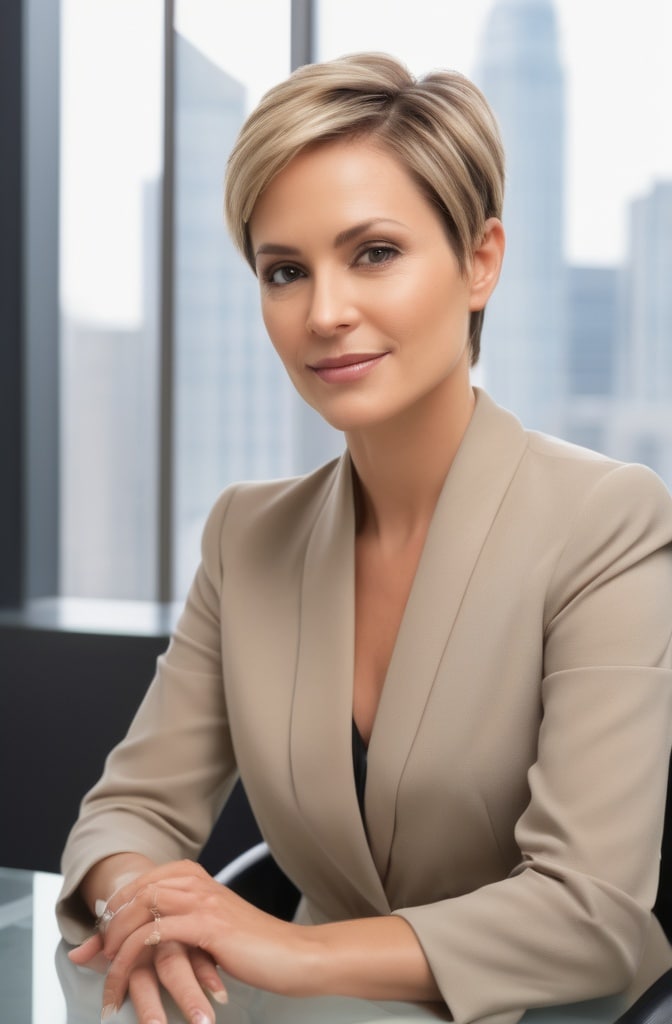
The feathered pixie with elongated nape keeps the traditional short sides and textured top of a classic pixie but leaves significantly more length at the nape of the neck, creating an interesting mullet-inspired silhouette that’s both current and unique. This contemporary twist preserves the face-framing benefits of a pixie while creating unexpected length at the back that can be styled for additional texture and movement. The feathering technique ensures the longer nape blends with the shorter elements rather than appearing disconnected.
This variation has become increasingly popular among my more fashion-forward clients who want something unexpected that still maintains the practicality of a short cut. The elongated nape offers styling versatility that traditional pixies lack—it can be tucked under for a more classic look, texturized for an edgier vibe, or even braided or twisted for special occasions. It also serves as an excellent transitional style for growing out a pixie, allowing the back to gain length while the top and sides remain manageable and styled.
38. Feathered Pixie with Carved Lines
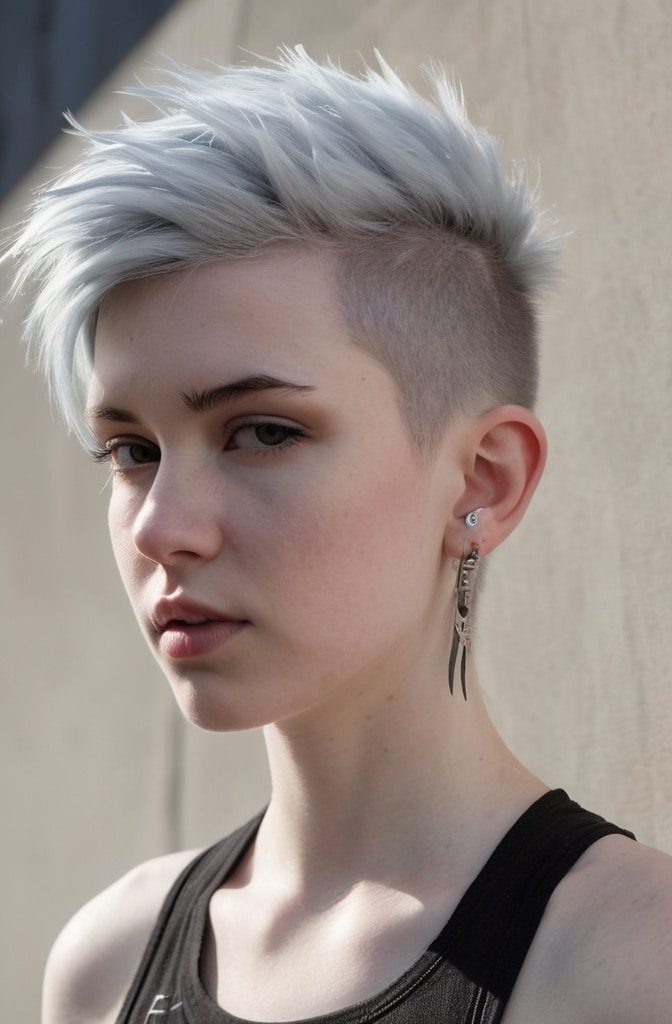
The feathered pixie with carved lines incorporates deliberate, razor-cut lines or patterns, typically at the nape or sides, that create visual interest and personalized detail within an otherwise classic pixie silhouette. These architectural elements—which might include geometric shapes, curved lines, or even abstract patterns—add an unexpected edge to the softness created by the feathering technique throughout the rest of the cut. The juxtaposition between the precise lines and the textured layers creates compelling visual contrast.
What makes this variation so special is the way it allows for personal expression within a classic framework—the carved elements can be as subtle or as dramatic as the client prefers, and can even be changed with each haircut to create an evolving style. For my clients who work in creative fields or who simply want there pixie to have a distinctive element that sets it apart, these carved details offer the perfect solution. They’re also incredibly photogenic, creating interesting shadows and lines that photograph beautifully from multiple angles.
39. Feathered Pixie with Voluminous Top
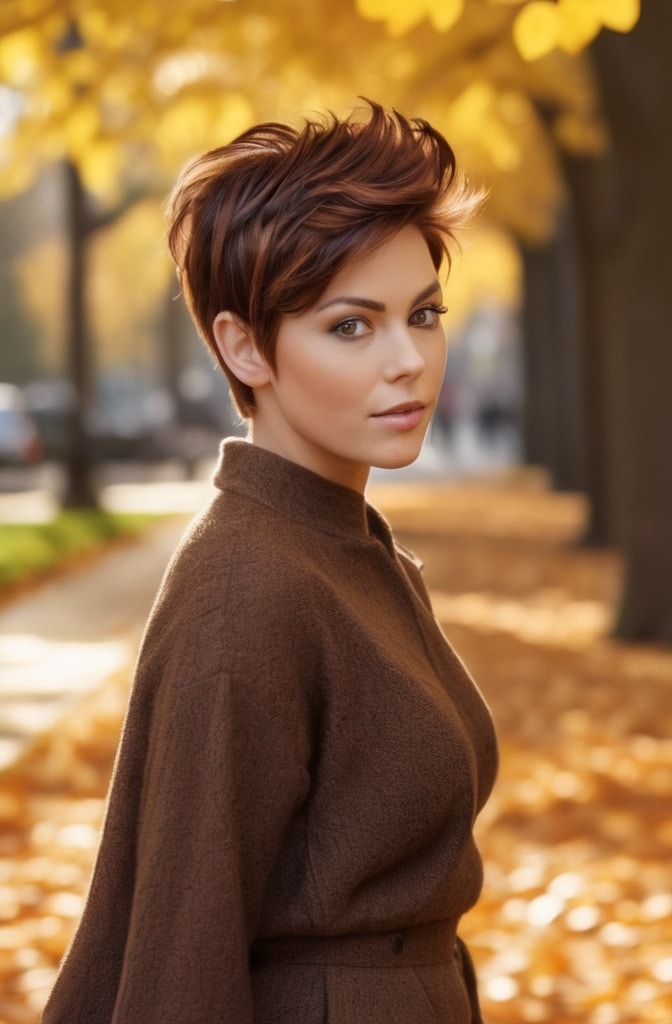
The feathered pixie with voluminous top maintains traditional pixie proportions but incorporates significantly more length and layering on top, creating dramatic height and movement that contrasts with the closer-cut sides and back. This bold interpretation uses feathering techniques to ensure the volume doesn’t translate to heaviness, with the longer layers cut to encourage lift at the roots and movement through the ends. The result is a dynamic silhouette with rockstar energy that still maintains the practicality of a pixie.
For clients with natural texture or wave, this variation capitalizes on there hair’s natural tendencies, allowing for volume where it’s most flattering while keeping the sides and back close for a clean, manageable perimeter. I often recommend this style to those transitioning from longer cuts who aren’t ready to lose all there styling options—the longer top can be slicked back, pushed forward, styled with finger waves, or texturized depending on the occasion, offering versatility that many pixies lack.
40. Feathered Pixie with Shadow Root
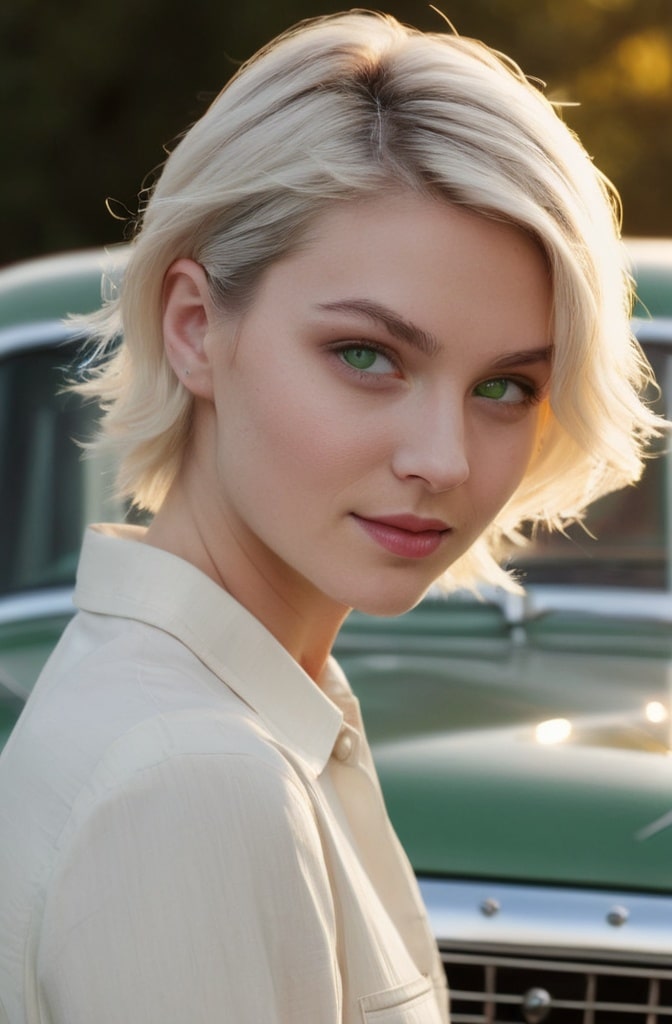
The feathered pixie with shadow root combines cutting and coloring techniques for a dimensional result, featuring deliberately darker roots that graduate to lighter ends, enhancing the movement created by the feathered cutting technique. Unlike traditional root grow-out, this color approach is intentional, with the colorist creating a soft transition between the darker base and lighter ends that follows the architecture of the cut. The shadow effect adds depth and dimension that makes the feathered layers pop.
This color strategy has become increasingly popular among my clients for both its aesthetic appeal and its practical benefits. The intentional darker root means less obvious regrowth, extending the time between color appointments by weeks or even months compared to all-over lightening. The dimension created by the shadow technique also enhances the texture of the feathered cut, making fine hair appear thicker and more dynamic. Its a perfect example of how cutting and coloring techniques can work together to create a result thats greater than either would achieve alone.
41. Retro Feathered Pixie
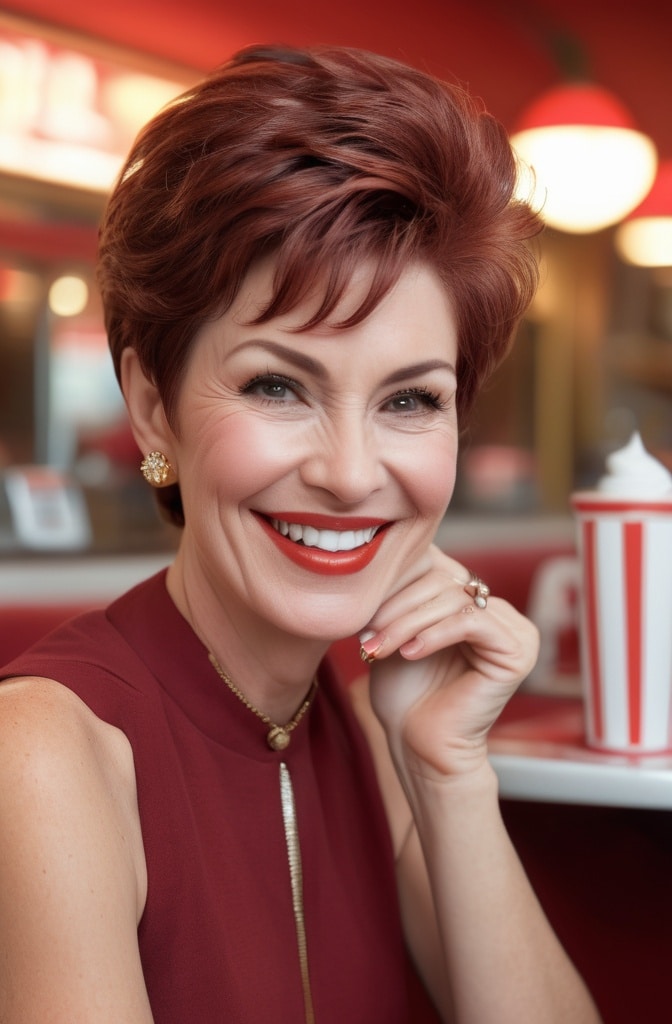
The retro feathered pixie draws inspiration from iconic short cuts of the 1950s and 60s, featuring elements like micro-bangs, curved silhouettes, and traditional feathering techniques that hearken back to the golden age of pixie cuts. This nostalgic variation incorporates vintage elements that have been updated for contemporary relevance, with modern cutting techniques ensuring the final result reads as intentionally retro rather than outdated. The feathering technique, which originated in this era, is used authentically to create the soft texture these iconic cuts were known for.
What I love about this style is how it connects the wearer to a rich history of iconic women who chose short hair as a statement of independence and modernity. For clients with an appreciation for vintage aesthetics, this cut offers a way to channel that sensibility without looking like they’re wearing a costume. The retro elements can be as subtle or as pronounced as desired—from a hint of Audrey Hepburn in the fringe to full Mia Farrow-inspired proportions—allowing for personalization within the vintage framework.
42. Feathered Pixie with Invisible Layers
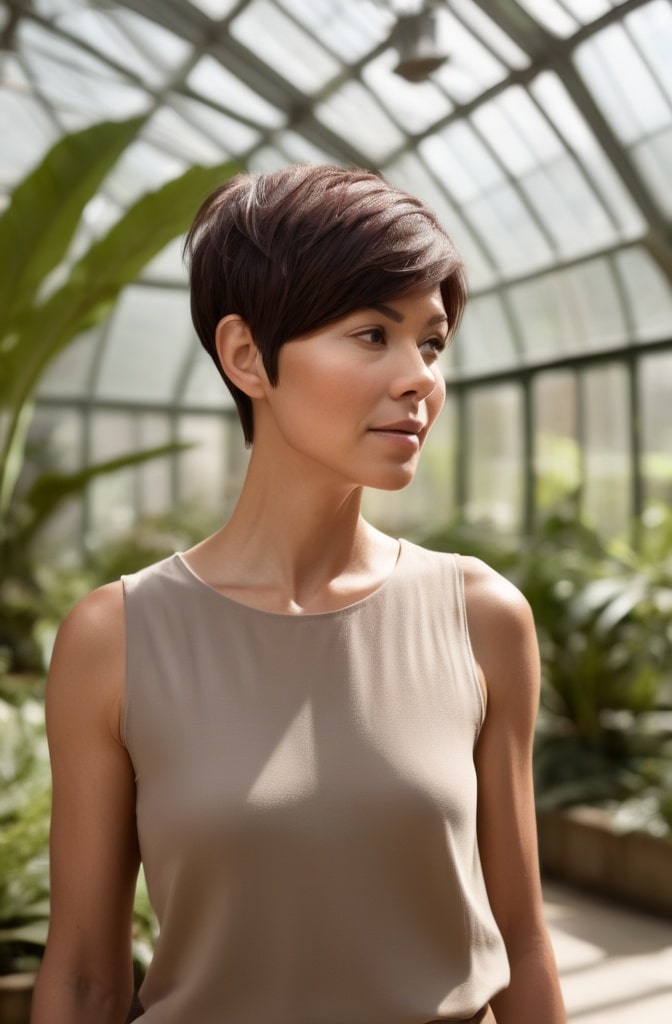
The feathered pixie with invisible layers incorporates subtle, technical layering that creates movement and texture without obvious layer lines or visible weight differences throughout the cut. This sophisticated approach uses specialized cutting techniques like slide-cutting and over-direction to remove weight and create movement without the “stepped” appearance that traditional layering can create. The feathering technique is applied to the ends to enhance the natural movement created by the invisible layers.
This style represents the height of technical cutting precision—the kind of haircut that doesn’t reveal its secrets upon casual observation but demonstrates its quality through how it moves and how easily it styles. For my clients with fine or straight hair, this technique creates natural-looking volume and movement that appears to be the hair’s natural tendency rather than the result of a specific cutting pattern. Its the hair equivalent of “no-makeup makeup”—the careful craft behind it remains invisible while the beautiful result speaks for itself.
43. Feathered Pixie with Diagonal Fringe
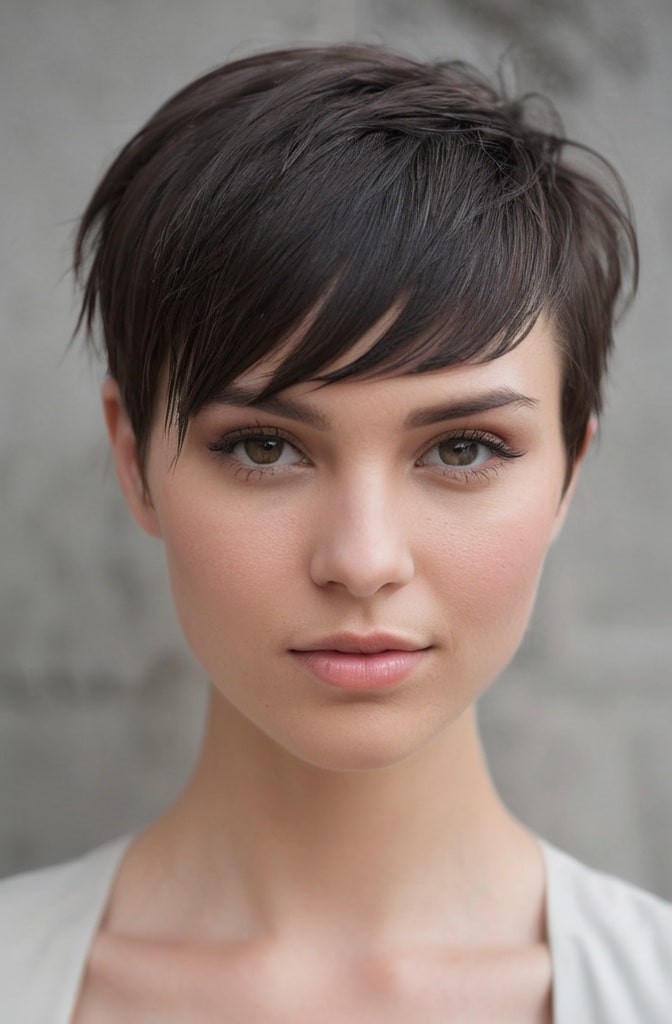
The feathered pixie with diagonal fringe features a bang that cuts across the forehead at a deliberate angle, typically starting shorter at one temple and gradually lengthening as it crosses to the opposite side. This architectural element creates a dynamic line that draws the eye diagonally across the face, with the asymmetry adding interest and edge to the otherwise classic pixie silhouette. The feathering technique softens what could be a harsh diagonal line, ensuring the fringe has movement and blends with the rest of the cut.
The diagonal direction of this fringe makes it particularly effective for balancing asymmetrical facial features or creating optical illusions that enhance the wearer’s natural bone structure. Many of my clients are surprised by how this simple directional change can completely transform there appearance—softening a strong jawline, balancing a slightly off-center nose, or drawing attention to there best features. It’s also remarkably flattering in photographs, creating interesting angles that catch the light in ways that straight-across or side-swept bangs don’t achieve.
44. Feathered Pixie for Transitioning Hair
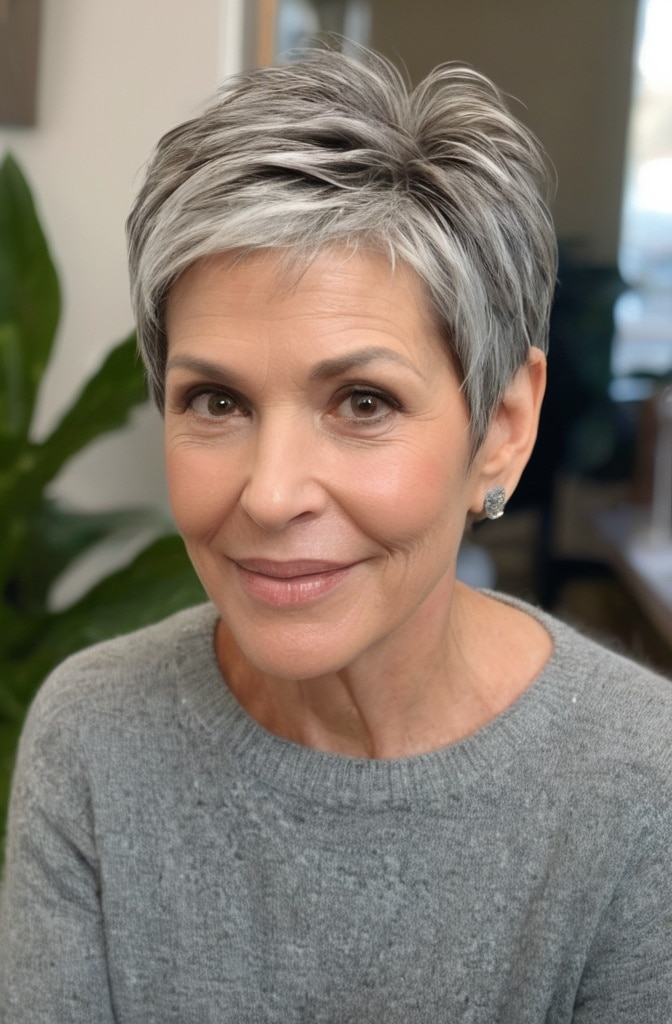
The feathered pixie for transitioning hair is specially designed for those growing out chemically processed hair (relaxed, permed, or color-treated) to embrace their natural texture, incorporating cutting techniques that work with both the processed and new growth sections. This thoughtful approach uses feathering to create a cohesive look during the awkward in-between stage, removing bulk from the processed ends while preserving length where possible to minimize the growing-out period. The result is a stylish, intentional look rather than an obviously transitional one.
For my clients undergoing the sometimes challenging journey back to their natural texture, this cut can be transformative—suddenly what felt like an awkward “growing out phase” becomes a purposeful, stylish choice. The feathering technique is particularly valuable during transition because it softens the often stark line between different textures, creating a more blended appearance between processed ends and natural roots. Many clients are surprised to discover that the pixie stage of there transition becomes there favorite part of the journey, offering a fresh start and immediate liberation from damaged ends.
45. Feathered Pixie with Crescent Fringe
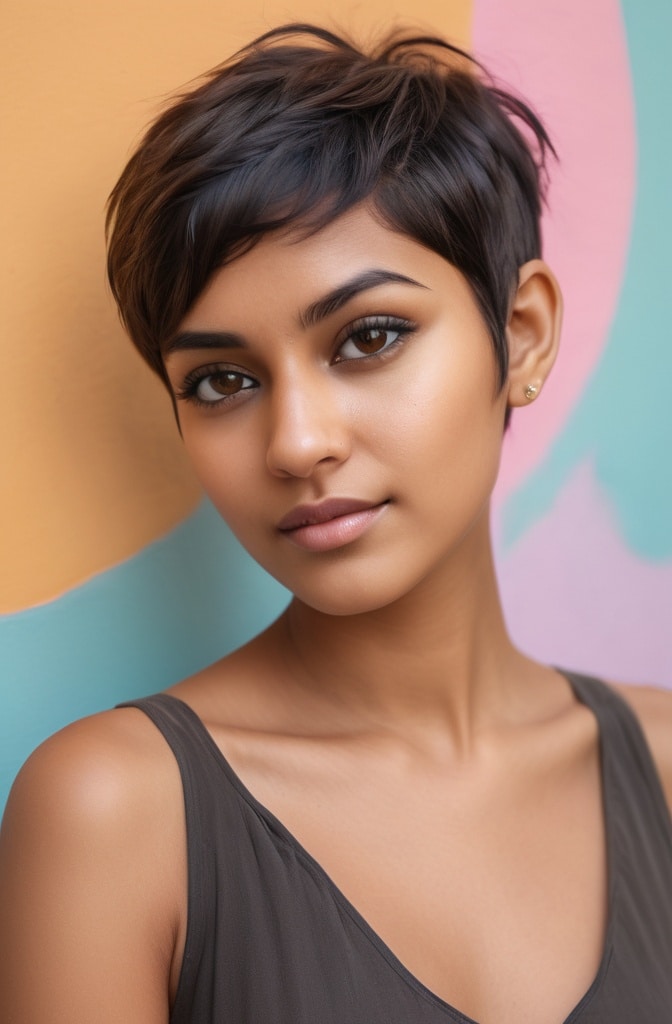
The feathered pixie with crescent fringe features a curved bang that follows the natural arc of the eyebrows, creating a soft frame that opens up the eyes and accentuates their shape. This face-enhancing variation uses the natural curve of the eyebrows as a guide for fringe placement, with the feathering technique ensuring the bangs have movement and texture rather than creating a solid curtain across the forehead. The result is a harmonious, eye-centric look that draws attention to one of the face’s most expressive features.
What makes this approach so universally flattering is the way it echoes existing facial architecture—by mirroring the natural curve of the eyebrows, the fringe creates continuity and flow that feels organic rather than imposed. For my clients with particularly expressive eyes, this fringe variation becomes a perfect frame that enhances there natural beauty. The crescent shape also has practical benefits, typically requiring less frequent trims than straight-across bangs as the curved shape grows out more gracefully.
46. Feathered Pixie with Flipped Ends

The feathered pixie with flipped ends incorporates a subtle outward bend at the perimeter, creating a playful, retro-inspired silhouette that adds volume and movement to the classic pixie shape. This styling-focused variation uses the feathering technique to create ends that naturally want to flip outward rather than lying flat, with the weightless ends catching air and movement throughout the day. The result is a dynamic, youthful look that combines vintage charm with contemporary proportions.
This style works beautifully for clients with naturally straight hair that lacks volume, as the flipped ends create the illusion of fullness and movement that might otherwise be difficult to achieve. The retro element offers a touch of nostalgia without looking dated, channeling the playful energy of 60s icons like Twiggy but with modern proportions and cutting techniques. Many of my clients are surprised by how such a subtle detail—just a small flip at the ends—can completely transform the energy of there pixie from serious to spirited.
47. Feathered Pixie for Round Faces

The feathered pixie for round faces incorporates strategic elements that create the illusion of length and angles, featuring slightly longer layers on top that add height, side-swept components that create diagonal lines, and feathering throughout to ensure softness despite the architectural approach. This face-specific variation uses visual tricks to counterbalance fullness in the cheek area, with carefully placed layers that draw the eye vertically rather than horizontally. The result is a flattering frame that makes round faces appear more oval.
What makes this approach so effective is how it uses both cutting techniques and styling direction to create optical illusions that enhance the wearer’s natural features. For my round-faced clients who’ve been told they “can’t wear short hair,” this customized pixie often becomes a revelation—suddenly they have cheekbones they never knew existed and jawline definition that wasn’t apparent with longer styles. The feathering technique is essential here, as it prevents the necessary structure from looking too severe against softer facial features.
48. Feathered Pixie with Airy Texture
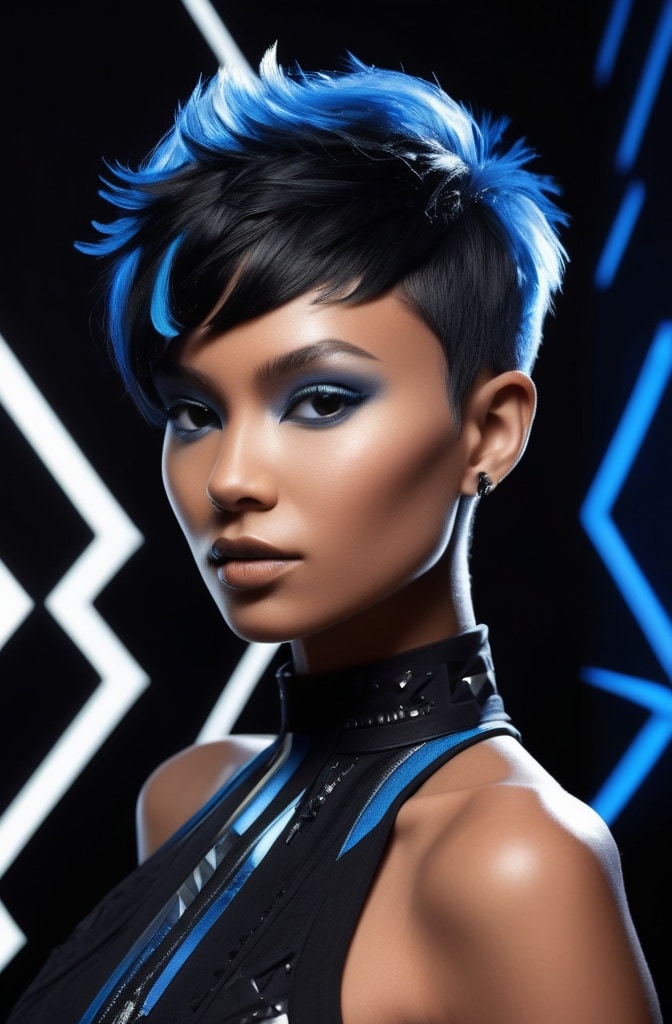
The feathered pixie with airy texture takes feathering to its extreme, creating ultra-light, almost weightless ends throughout the cut that create exceptional movement and a cloud-like quality to the hair. This specialized approach uses extensive texturizing and thinning techniques beyond standard feathering, removing significant interior weight while maintaining the outer shape. The result is hair that moves with the slightest breeze or head turn, creating dynamic texture even without styling products.
For clients with thick, heavy hair that tends to lay flat despite layering, this technique can be revolutionary—suddenly their hair has the movement and lightness they’ve always envied in others. The airy texture creates natural volume without bulk, with the hair appearing to float rather than hang. I often describe this cut to my clients as “anti-gravity hair”—it defies the natural tendency of hair to lay flat, instead creating dimension and movement that seems to defy physics even on second or third-day hair.
49. Feathered Pixie with Geometric Elements
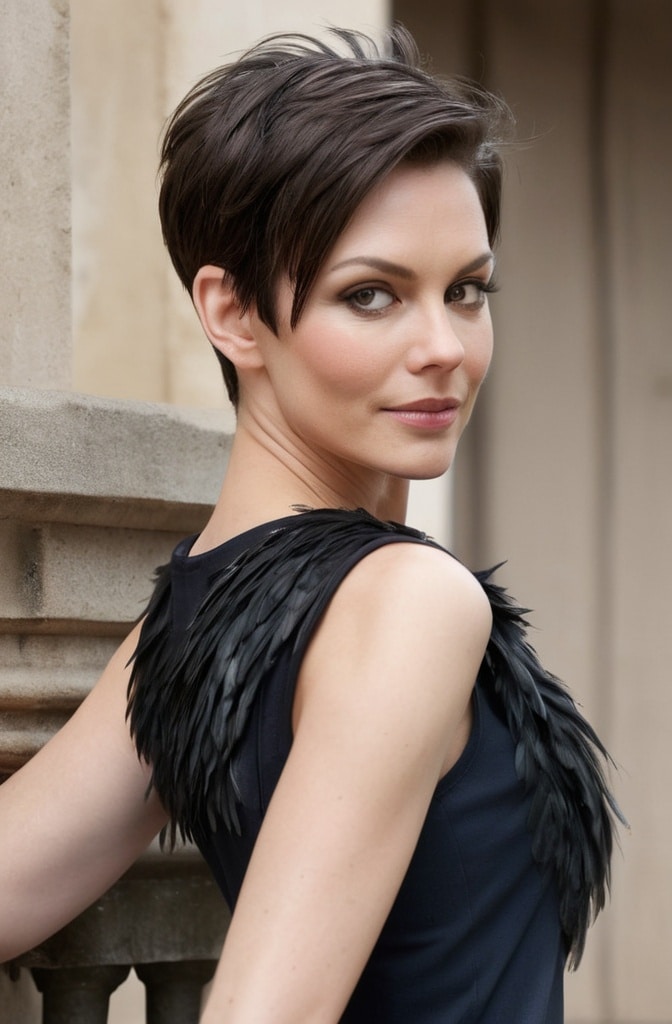
The feathered pixie with geometric elements incorporates deliberate straight lines or angles in specific areas of the cut, creating architectural precision that contrasts with the softness of the feathered sections. This artistic approach might include elements like a perfectly straight fringe, sharp temple angles, or precise perimeter lines, with feathering used strategically throughout the rest of the cut to prevent an overall harsh appearance. The juxtaposition between geometric precision and feathered softness creates visual interest and contemporary edge.
This style walks the perfect line between feminine and bold—the geometric elements add strength and intention to the cut while the feathering maintains approachability and movement. For my clients who work in creative or design-oriented fields, this architectural approach often resonates with there aesthetic sensibilities, allowing there haircut to become an extension of there personal style. The precision required for the geometric components means this isnt a wash-and-go style, but for those willing to invest a few minutes in daily styling, the distinctive result is well worth the effort.
50. Feathered Pixie with Brushed-Back Crown
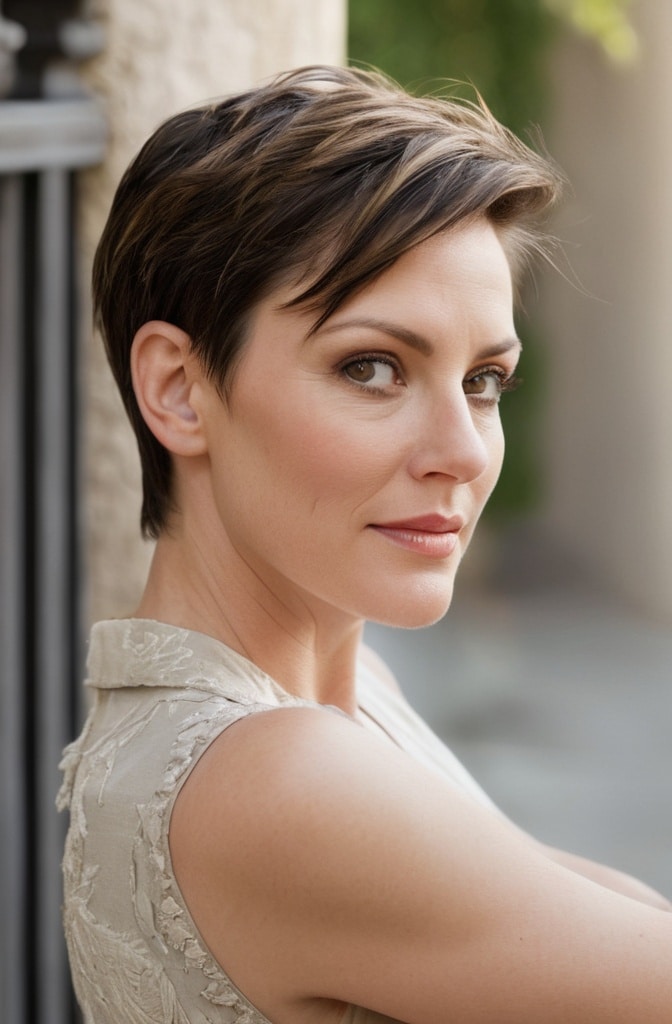
The feathered pixie with brushed-back crown features longer layers through the top section that are styled away from the face, creating height and volume at the crown while maintaining the short, sleek silhouette of a pixie around the perimeter. This voluminous variation uses feathering techniques to ensure the brushed-back sections have movement and softness rather than appearing stiff or helmet-like. The result is a confident, powerful silhouette with a touch of rockstar attitude.
The brushed-back direction opens up the face completely, showcasing features and creating a confident, powerful look that my clients often describe as making them feel “unstoppable.” This style is particularly effective for those with strong features or distinctive facial characteristics they want to highlight rather than hide. The feathering technique is crucial to the success of this variation, as it prevents the brushed-back sections from looking too solid or severe, instead creating piece-y texture that moves naturally even in windy conditions or throughout a long day.
51. Feathered Pixie with Horseshoe Parting

The feathered pixie with horseshoe parting features a distinctive U-shaped section on top that creates volume and height while the sides remain sleek and close-cut. This architectural approach uses a technical parting pattern that follows the natural curve of the crown, creating a mohawk-like shape without the severity of a traditional mohawk. The feathering technique softens the edges of this defined section, ensuring the dramatic shape maintains movement and feminine appeal despite its bold silhouette.
This style has roots in punk and alternative fashion but has evolved into a surprisingly wearable option for those seeking something distinctive without going to extremes. I find it particularly effective for clients with naturally dense hair on top who struggle with flatness in traditional pixies—the horseshoe section capitalizes on that density where its most beneficial while removing it where it would create unwanted bulk. Many of my clients are amazed at how this technical parting completely transforms there styling options, allowing for dramatic height when desired or a more subdued look when smoothed down.
52. Feathered Pixie with Scalloped Fringe
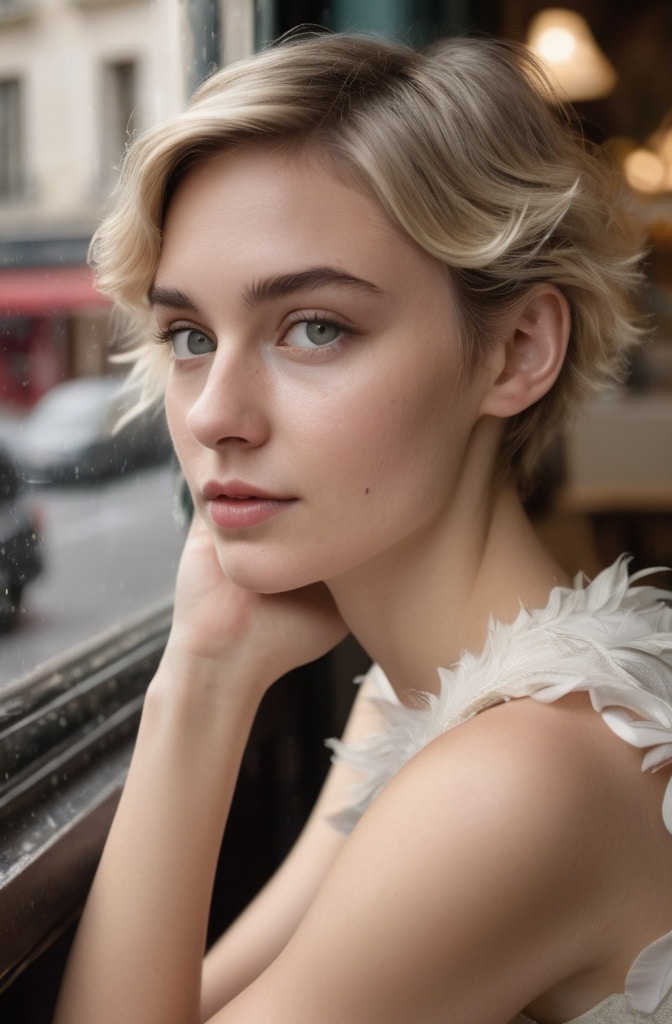
The feathered pixie with scalloped fringe incorporates a deliberately uneven, wave-like pattern across the forehead, creating a soft, organic line that frames the face with whimsical irregularity. Unlike straight or curved bangs, this artistic variation features subtle peaks and valleys across the fringe line, with feathering techniques used to soften each point for a delicate, almost fairy-like quality. The undulating line creates natural movement and visual interest even without styling products.
What makes this approach so special is how it softens the overall look of the pixie while adding an element of the unexpected—the scalloped edge catches the light in interesting ways and creates natural movement that draws attention to the eyes. For my clients with playful personalities or those in creative fields, this detail becomes a signature element that sets there pixie apart from more conventional cuts. The irregular edge also has practical benefits, as it grows out more gracefully than a straight line, with the varying lengths blending together as the hair lengthens.
53. Feathered Pixie with Concave Layers
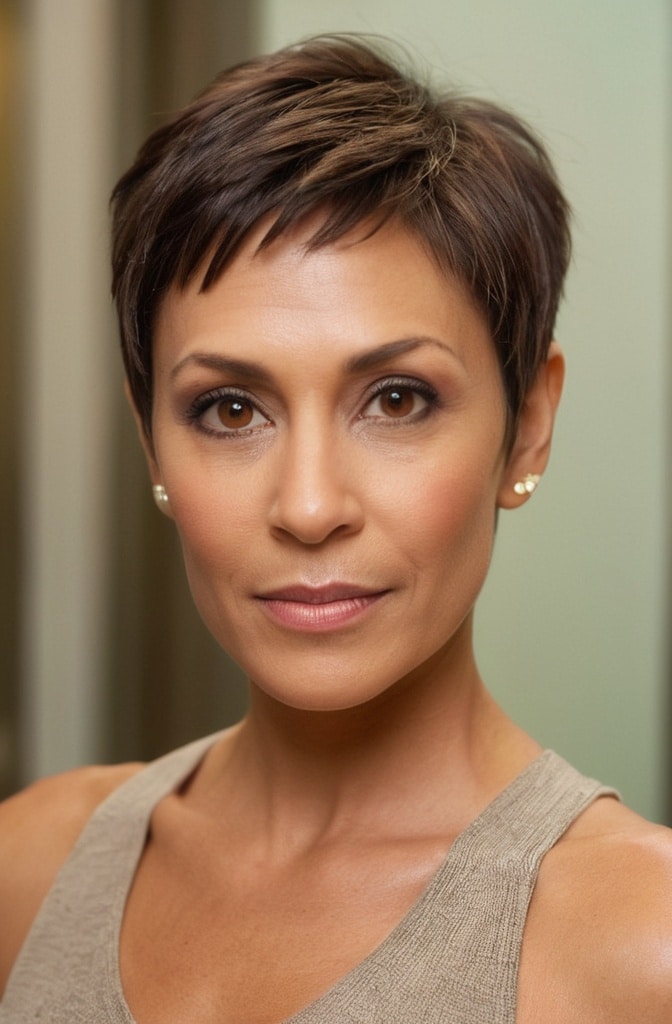
The feathered pixie with concave layers uses an advanced cutting technique where the layers are shortest at the crown and gradually lengthen toward the perimeter, creating a bowl-like shape that hugs the head for a sleek silhouette with internal movement. This architectural approach creates layers that aren’t immediately visible but reveal themselves through movement, with the feathering technique ensuring the ends have softness and dimension despite the precision of the shape. The result is a technical marvel that combines structure with fluidity.
This cutting pattern creates a unique dynamic where the hair appears to collapse inward rather than stick out, making it ideal for clients with thick hair who want a close-fitting pixie without the bulk that traditional layering might create. The concave approach requires significant technical skill to execute properly, as it involves cutting the hair against its natural fall pattern to create the desired shape. For clients willing to commit to regular maintenance, this style offers architectural precision that looks incredible from every angle, with the shape actually improving as it grows rather than falling apart between cuts.
54. Feathered Pixie with Chandelier Layers
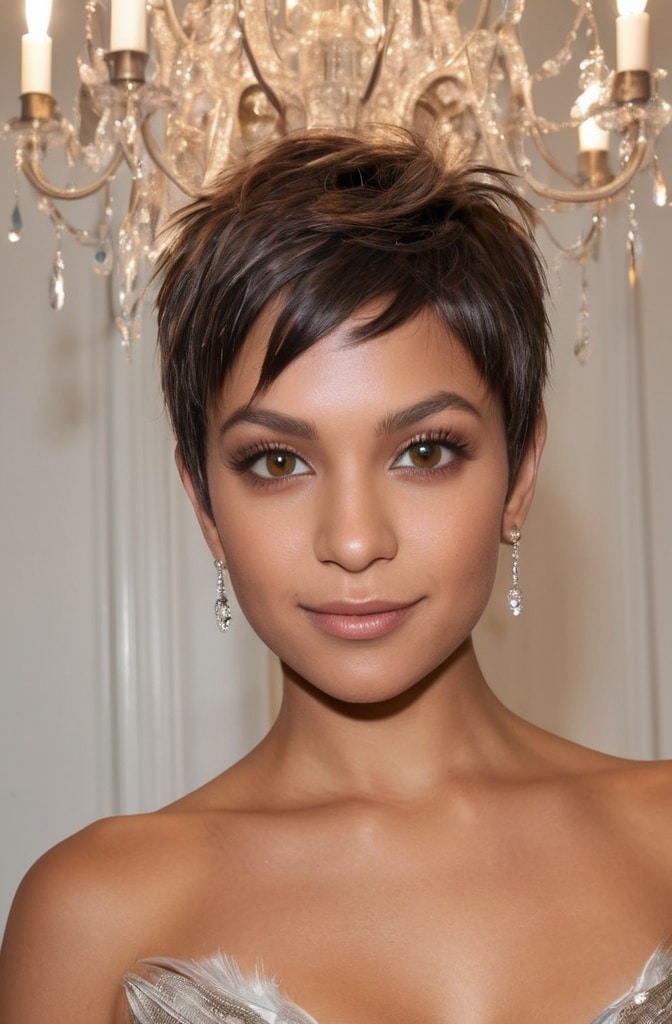
The feathered pixie with chandelier layers features long, wispy pieces that hang down in front of the ears and along the nape, creating the effect of delicate tendrils suspended from the more structured pixie shape above. This romantic variation maintains the classic short crown and sides of a traditional pixie while deliberately leaving strategic longer sections that create vertical lines framing the face and neck. The feathering technique ensures these longer pieces have ethereal lightness rather than appearing heavy or disconnected.
The suspended, chandelier-like quality of these layers creates movement that’s both beautiful and flattering, with the longer pieces softening the jawline and elongating the neck in a way that’s universally flattering. For my clients transitioning from longer styles, these strategic longer sections provide emotional security while still allowing them to enjoy the freedom of a primarily short cut. The vertical orientation of the layers means they require minimal styling—they naturally fall in a graceful pattern that enhances facial features while framing the face with soft, feminine lines that catch the light beautifully.
55. Feathered Pixie with Negative Space
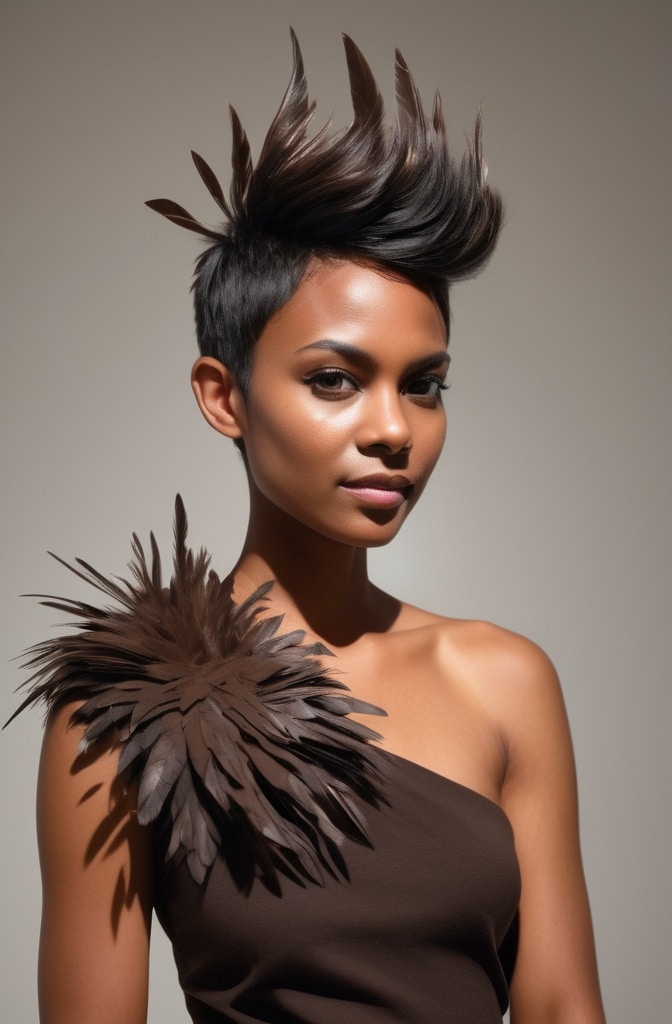
The feathered pixie with negative space incorporates deliberate areas of ultra-short or even shaved sections that create visual “gaps” within the overall silhouette, typically located at the temples, above the ears, or at the nape. This contemporary approach uses the contrast between these nearly-bare areas and the feathered, textured sections to create architectural interest and unexpected edge. The feathering technique is crucial to softening the transitions between the negative space and the longer sections, preventing harsh lines that would disrupt the cohesive feel of the cut.
This avant-garde variation appeals to my most fashion-forward clients who want something that pushes creative boundaries while remaining wearable for everyday life. The strategic placement of negative space can be used to highlight bone structure, create optical illusions that enhance facial features, or simply add an element of surprise to an otherwise classic silhouette. What I find most interesting about this approach is how dramatically it can change depending on styling—when the hair is deliberately arranged to reveal the negative space, the effect is bold and editorial, but when allowed to fall naturally, the negative space peeks through subtly, creating intriguing glimpses that catch the eye without overwhelming the overall look.
Conclusion
In conclusion, the feathered pixie in all its variations offers something for virtually every woman, regardless of age, face shape, or lifestyle. The beauty of this versatile cut lies in its adaptability and the way it can be customized to enhance individual features while expressing personal style. If your thinking about making the chop, I’d encourage you to bring reference photos to your stylist, but also remain open to their suggestions for adaptations that might better suit your specific hair texture and face shape.
Remember that the perfect pixie is one that not only looks great but feels right for you one that aligns with your maintenance preferences, styling abilities, and personal aesthetic. With the right cut and a few simple styling products, a feathered pixie can be the most liberating, confidence-boosting hair decision you’ll ever make. Trust me, after over a decade of creating these transformative cuts, I’ve seen firsthand how the right pixie can quite literally change how a woman carries herself in the world shoulders back, chin up, and ready to take on anything with style and ease.
